Joshua Warren's Blog
July 1, 2024
How Retired Policemen helped me Research The Starseed
I've previously written about some of the unique challenges that arises when writing about an archeologist, not only for the obvious reason that I am not one myself (though the subject has fascinated me greatly since I was a child), but also how I have had to force myself to focus my research primarily on "outdated" knowledge as any modern information found online would not be relevant when writing about a mid-20th century academic like Professor Korrigan. I wrote about this in another article titled My "Outdated Archaeology Library.
However, since The Starseed is primarily a crime story with elements of archaeology sprinkled in throughout, I was faced with the additional challenge of having to get into the specifics of Norwegian law enforcement in the mid-1970s, something which would never have been possible if not for a handful of people associated with The National Museum of Justice and The Norwegian Police History Society. In this article I would like to add additional thanks to these individuals while also explaining in further detail than what I did in the book's short acknowledgments section on how exactly they helped make my novel as authentic as it is.
 The main entrance to the National Museum of Justice in Trondheim, Norway.
The main entrance to the National Museum of Justice in Trondheim, Norway. Wikimedia Commons photo by Wolfmann.
When I first started work on The Starseed I did what most people do when researching any given subject nowadays, I used Google. However, I quickly found that this was quite limiting. I have often found that the internet is rarely the best source of information regarding esoteric subjects, especially here in Norway. Now, if I'd have to solve similar issues related to law enforcement in say, the US or the UK, then it would likely have been a completely different story. The problem with Norway, however, is not so much that the information doesn't exist, but rather that there aren't enough people to allow the information to trickle on to the internet. The population is simply too small. In America, at least when compared to Scandinavia, there is simply no such thing as a niche. Even the smallest and most esoteric of niches, even if the percentage of the population remains as low as in Norway, you're still likely to find thousands, if not tens of thousands, or even hundreds of thousands of people within said niche. America does have a population of over 300 million people after all. Norway in comparison has only 5.
So, when the internet failed me it became clear that I'd have to go directly to the source of the information that I wanted—which is a lot more fun anyhow. But where to start?
 The extensive digital archives on digitaltmuseum.no proved an invaluable source during the writing process.
The extensive digital archives on digitaltmuseum.no proved an invaluable source during the writing process.
Now I must point out that I did have some luck with my online research, mostly thanks to the digital archives at digitaltmuseum.no where I found several photos of items belonging to the police from the middle of the 20th century. However, the labels weren't always too specific on precisely when these items had been used. They preferred to give very broad and general periods of use, usually measured in decades. I did however quickly find that all of them belonged to the same museum, The National Museum of Justice in Trondheim.
Now Trondheim is a fair bit further north in Norway from where I live and at the time going there in person wasn't really an option, but I now had a handful of vaguely labelled photos that I felt gave me a decent sense of what the police men in my current draft would likely have used and decided to contact the museum in the hopes that someone there could help me confirm or correct my assumptions. I've found that it's much smarter to ask for corrections rather than blank-slate questions that effectively boils down to "do the research for me." I quickly got a reply from Hilde Haaverstad Olsø, the collection administrator & conservator and she not only replied to my list of questions, she also forwarded my request to two individuals with direct experience in law enforcement during the period of my book's setting; retired Kripos investigator Oddmund Dahle & retired police superintendent Magnar Skaret.
Dahle was largely responsible for helping me confirm that my depiction of Kripos, both for The Starseed and a brief appearance in another novel I'm working on, was largely accurate. Although this book never goes too deep into Kripos operations, it was important to me that the character of Kripos Investigator Harald Hagen, and his function within the story, was completely in line with the duties and jurisdiction of Kripos back in the 1970s. Early in our correspondence it quickly became apparent that although my depiction of Hagen himself was quite accurate, I had overestimated the full range of Kripos' responsibilities and how they cooperated with other branches of the law. This forced me to make some necessary adjustments to the later chapters in the book where I depicted a police raid on the novel's antagonists, the Environmental Liberation Front (ELF) eco-terrorists. A bit more on this later.
All in all though, it was really interesting to get to exchange emails with an actual former Kripos investigator, something which I had not predicted when I began work on this novel.
Moving on from Kripos, it must be said that it is Magnar Skaret, a retired police superintendent & chief of staff from Trondheim, who deserves the bulk of the praise when it comes to my depiction of the Norwegian police in the The Starseed. Skaret went beyond simply answering the myriad of questions that I kept sending his way, he was also generous enough to send me copies of two books that he'd written for the The Norwegian Police History Society. Actually, calling them books don't do them justice, they are more like tomes.
After having corresponded with Skaret for a while it became clear to him that the information I was after went well beyond general information about police duties, but ventured into very specific esoterica, something which, thankfully, Skaret was very much the right man for. Of course, no one can be expected to remember every little detail about police equipment, uniforms, procedures, etc. so he concluded that the best thing to do would be to send me copies of the two books he had written and published at this point. What I received in the mail about a week later were two massive volumes dense with information on every imaginable detail related to their broad subject matters. I almost feel a little bad for having since left these two books lying on a shelf where they have remained largely untouched as I only needed a tiny fraction of the vast knowledge contained within.
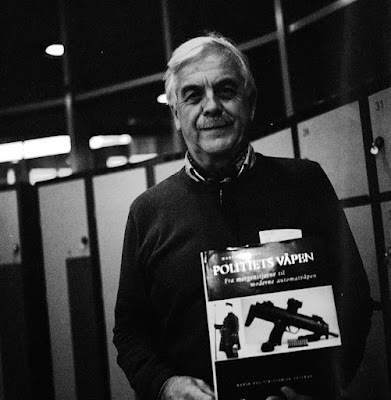 Magnar Skaret with his book on police weapons throughout the years.
Magnar Skaret with his book on police weapons throughout the years. Photo by S. Aarsbog.
Where these books proved the most useful was for the aforementioned raid depicted towards the end of the novel. After having been corrected by Oddmund Dahle that Kripos would not have been directly responsible for such an operation, I had to figure out exactly who would have been the natural choice. Since Skaret had, among his diverse range of duties over the years worked with Beredskapstroppen, AKA Delta Unit, he recommended that I include them in the book. This did pose a bit of a problem as Delta Unit was not made operational until January 11, 1976, about ten months after the setting of my story. Int he end, however, I decided to bend the facts ever-so-slightly in my favour, and included them despite this minor timing anachronism. Yes, there was a somewhat similar unit present before called Østlandstroppen, though I never quite felt that this group had the correct training that was required for my fictional raid. Instead I decided to conjure up a secret early trial run of the unit, something which would have been quite plausible as the suggestion to form Delta Unit had been greenlit by the police in January of that same year.
My depiction of Delta may not be 100% accurate as far as timing is concerned, but their uniforms, equipment, weaponry, and their overall function in the story is completely within the realms of reality had the unit been operational ten months earlier.
Skaret, Magne. 2009. Fra Varde til SMS: Politiets Sambandshistorie. Oslo: Norsk Politihistorisk Selskap. The title roughly translates to "From Cairns to SMS: The History of Police Communications."
Skaret, Magne. 2017. Politiets Våpen: Fra Morgenstjerne til Moderne Automatvåpen. Oslo: Norsk Politihistorisk Selskap. The title roughly translates to "Police Weapons: From morning stars* to automatic rifles."
*In case you were wondering what a morning star is, it refers to several types of club-like weapons consisting of a shaft with a spiked ball attached to the top. These were quite common with the night watchmen ('Vekter' in Norwegian) that up until about 150 years ago patrolled the streets with only said club and a lantern. There's actually a well know statue in my hometown of Stavanger depicting one of these watchmen with a morning star in one hand and a lamp in the other (though the latter, minus the handle, was stolen many years ago). You can see a photo of watchman with a morning star on the cover of the 2nd (green) book below.
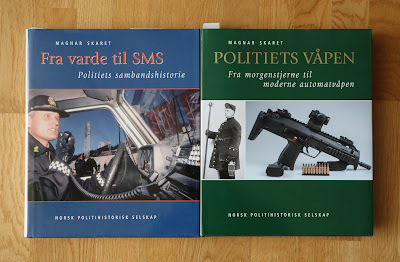 Skaret's tomes on police communications and weaponry.
Skaret's tomes on police communications and weaponry.
I would also like to point out that Skaret recently added a third book to his bibliography, this time focusing on police vehicles titled Til lands og til vans og i luften med Politiets Transportmidler. While I was making the final adjustments on The Starseed and sending my final questions to Skaret (I think it was about Delta Unit communications) he informed me that he just handed in the final draft of this book, at over 600 pages. The book was published a few months later in early 2024 via NPHS.
I would like to once again thank Magnar Skaret, the late Oddmund Dahle (who passed away April 2024), Hilde Haaverstad Olsø, The National Museum of Justice and The Norwegian Police History Society for their help with my research for The Starseed.
April 2, 2024
Dawn of the Karabu Lore: The Animal Clans
The following text is taken from a "fact sheet" I made to assist me during the writing process of what would become my 2020 novel, Dawn of the Karabu. This second part is a summary of the culture, religion and social hierarchy related to the faction known as The Animal Clans. If you have not yet read the first part covering the human faction, you can read it here; The Children of the Light.
Whether this is merely a reminder or your first time reading about the world of my novel, I hope you will find it interesting.
I do, however, want to make it clear to anyone who has not yet read the book that this, and the previous article, are in no ways required to understand the world depicted in the novel. I took great care to reveal the lore piece by piece through the narrative in a natural manner, so please consider this as either reference material or as trivia.
NOTE: No story spoilers have been included in this article, but the nuances of the Animal Clans can by itself be considered mild spoilers for the 2nd half of the novel. The text has also been partially altered and updated from the original to fix some minor incongruities between the final novel and the original document. Most of the reference photos originally used had to be removed for copyright reasons and have been replaced with stock images.

War always marks the beginning of change - from the Extended Discourses by Bala-Chatur Ō-Inari.
THE UPLIFTING OF THE ANIMALS
Before the transfiguration of the Talos there was the great beast-war. With knowledge now lost, and for reasons intentionally forgotten, the first men to call themselves the Karabu uplifted the animals in the wild by bestowing them with human qualities. This angered the Talos, who strived for human perfection, and the practice was deemed heretical. - from A Summary of the History and Religion of the Children of the Light by The Master Chronicler in service of the Karabu Queen, first ruler of the 2nd dynasty.The first animals to be uplifted were the Apes; Chimps and Gorillas, due to their physiology and intellect being the closest to humans. They were used as warriors.
Second came the Pigs. They served humanity as labourers.
Third came the Dolphins, chosen for their intellect and manoeuvrability under water. It is said they were given artificial arms to carry out underwater repairs and even sabotage to the enemy navy. Little is known about their current state as they are, without their arms, completely indistinguishable from natural Dolphins. However, legends do persist among both humans and animals that tell of societies of intelligent Dolphins living somewhere in foreign oceans.
Finally, as a last effort to win the war, Foxes were uplifted and used as spies, saboteurs, and assassins.
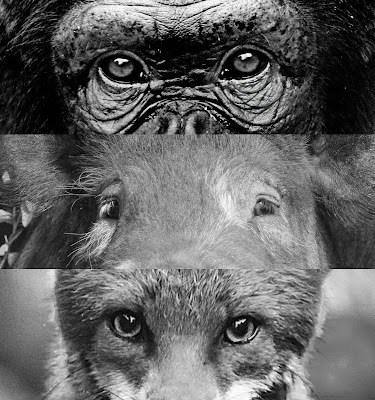 The Animal Clans is a triad consisting of the Ape Clan, the Pig Clan and the Fox Clan.
The Animal Clans is a triad consisting of the Ape Clan, the Pig Clan and the Fox Clan.THE ANIMAL CLANS
THE APE CLAN
The Saru Kuran (lit. “Ape Clan”) are the warriors of the Animal Clans. They follow a strict warrior code. Honour and authority are of the utmost importance to them. Since their ancestors once fought side-by-side with humans they speak the same language, albeit with some different words (the same applies to the Pigs and the Foxes). In addition to speech, they employ a complex sign language. This is said to be a remnant from their pre-uplift years, from before Man taught them to speak. Their use of sign language has proven itself useful in battle as a silent way to give orders and tactical information.
Military
All warfare is based on deception. Appear weak when you are strong, emerge where you are not expected, then strike when your opponent thinks he is untouchable. - excerpts from A Treatise on War by The Warlord Xerxes of the Chandra clan.
The majority of the Ape army is stationed in a series of fortified settlements lining the edge of the thin strip of desert, roughly 40km across, that divides the land of the Animal Clans from the territory of the humans. The sands of the desert stretches all the way from the western sea to a gap in the great mountain range referred to as the Shield Wall which protects them from the greater toxic desert known as the Forbidden Lands. Little is known of this mysterious wasteland other than what is told in myth and legend. It was once the domain of the mythic Talos, the name used by the humans before recorded history, before they used their now forgotten craft of uplifting. (For more on the legends of the Forbidden Lands refer to previous article on the Children of the Light.) Unlike the sands of the toxic desert the desert strip can be crossed without any harm beyond the natural perils of an inhospitable desert. It has effectively served as a neutral zone between the Animal Clans and the humans for several millennia, though in the past land has been occupied on either side.
The border forts, much like the human ones on the other side of the desert strip, though larger and more complex, are effectively partially self-sufficient towns surrounded by wooden battlements. Within can be found everything that an army needs to function and survive, and although they generally rely on a regular stream of supplies from the nearby Pig Region, they can, if needed, survive for several months in the even of a prolonged siege (though no human has set foot on Ape territory for several centuries, more so on a large scale). Each fort stands roughly 7km apart from its neighbour on either side.
The centre of all military activity, which can also be considered the closest the Apes have to a capital city, is called Durga Candrodaya ("Fort Moonrise"). It is the largest and most central of the forts and lies more-or-less parallel with the city of Tanagra on the other side of the desert strip.
The land considered part of the Ape Regions near the border consist of a fairly thin strip of land, functioning more as a secondary border between the desert strip and the nearby border to the Pig Regions. Although most of the Ape Clan's culture revolve around the military to some capacity, and most juvenile and senior Apes live among the Pigs, there are rural areas inhabited primarily by Apes, such as the tropical Wanay region to the north-west (the home of the gorillas). With this one exception, the Apes simply do not require as much land as the Pig Clan do, and the Ape Regions are therefore nearly synonymous with the land owned by the military.
Armour
Ape armour is made of braided leather scales interwoven with small metal plates. Although this offers far less protection than the steel-plate armour of the humans it has the benefit of allowing far greater movement, something which compliments the inherent agility of the apes. The lack of added weight also allows them to swiftly charge at their enemy. It is not uncommon for the humans to have to face down a horde of apes sprinting towards them on all four while screeching and howling as a means of demoralization.
 Though seemingly crude when compared to the elaborate steel-plate armour of the humans, Ape armour allowed greater mobility and stealth.
Though seemingly crude when compared to the elaborate steel-plate armour of the humans, Ape armour allowed greater mobility and stealth.Battle Rituals
Out gunned, and often outnumbered, the apes commonly use intimidation to gain the upper hand in battle. A common practice before a battle, when facing off against the enemy, is to rythmically beat-their chests to demonstrate strenght, resolve and battle-readiness. A general or commander (often a gorilla) will then call for a charge by stepping forward and giving a battle cry in the form of a ferocious roar.The chest-beating ritual is sometimes accompanied by a taunting chant intended to rouse the enemy into attacking first.
Headhunting has always been a common practice among the Ape Clan for as long as anyone can remember. When a battle is over a warrior will ceremoniously present trophy heads to his superiors (usually a general) who will in turn reward him with either promotion in rank, wealth, or land depending on the importance of the slain individual. The higher in status and caste the slain human is the higher the reward is. If the head belongs to someone of the utmost importance to human society, like f.ex a nobleman or a famous general, then it will be proudly displayed either in a public place or remain a priced possession of the general in charge of the battle. To achieve the latter the heads will be either mummified or shrunk in order to preserve them.
It is also common practice among the foot soldiers to collect human scalps to wear as decoration on their armour or as trophies in their homes. Silver hair of older members of the High Caste is especially prestigious.
Technology
Though their technology is quite crude compared to that of the humans, the apes are by no means primitive. Though they prefer to fight with blades, much like the humans, they possess an arsenal of sturdy and efficient flint-lock rifles. These are often used to fire off an initial volley to thin the ranks of Lumasi grunt spearmen protecting the Knights before they charge at them with their swords and/or daggers. Despite the heavy armour used by the Knights, the apes are well-versed in their weak-spots and can kill quickly with brutal efficiency.Apes have been known to employ crude grenades in battle, but prefer the more direct approach. Even rifles are seen as somewhat cowardly and have generally been used out of necessity ever since the humans started to employ firearms.
The introduction of aviation among the humans three centuries ago did for a while greatly shift the balance of power. Not only did it allow the humans to recon their lands in a way that had never before been possible, but the subsequent air raids also devastated their border forts, forcing them to retreat into the nearby forests for the first time in remembered history. The Apes, with help from the Pig engineers, did however quickly come up with an ingenious solution in the form of bamboo rockets.
Simple but efficient, these disposable anti-air rockets consist of four parts: an arrowhead packed with explosives, the arrow barrel, the arrow feather, and the gunpowder tube. The gunpowder tubes, made from hollowed-out bamboo trunks, are filled with gunpowder for propulsion. A small hole is drilled into the tube for the fuse. When ignited, the gunpowder burns inside the tube, producing a large amount of gas, which, while shooting backwards at high speed, produce enormous forward-propelling force. Though generally fired one at the time, usually by a pair of Apes (or an Ape with a Pig armourer) in a manner comparable to firing a mortar canon, it is quite common to see bamboo rockets fired from a 'battle-wagon' which allows for the near-instantaneous firing of dozens of rockets at once. Despite the unpredictability of the rockets' trajectory, their low production cost means that when fired off in large enough numbers they can provide a deadly barrage that will take down all but the most skilled pilots.
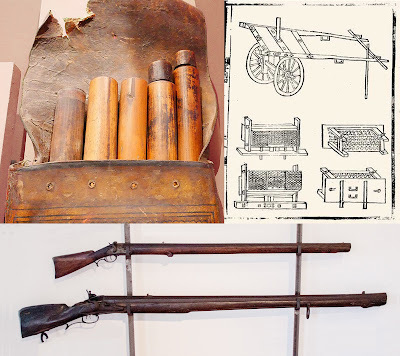 Despite considerably lagging behind the humans technology-wise, the Apes (and Pigs) have proven quite ingenious when it comes to weaponry.
Despite considerably lagging behind the humans technology-wise, the Apes (and Pigs) have proven quite ingenious when it comes to weaponry. Although not exclusively connected to the military, it is worth pointing out that the Apes are currently in the early stages of electricity-based technology and have in recent decades employed a simple but far-reaching system of telegraph wires, most between the border forts and various desert look-out posts, as well as the nearest Pig settlements, allowing them to efficiently warn of coming attacks or air raids. The code used derives from an ancient "talking drum" language employed by the Apes for as long as they can remember.
The Shogun
The current Shogun of the Ape army is General Khshayarsha (known as Xerxes among the humans) of the Chandra clan (“the Shining Moon clan”). Xerxes, which translates to “ruler over heroes”, was a name given to the general after he led the successful skirmish on Fort Alkaios. This was the first time in over a century that a force of apes had managed to get behind enemy lines.
His birth name was Bhadran (meaning “auspicious” or “fortunate one”) Chandraketu (meaning “moon banner”). The general is known for being a traditionalist and a stern leader, the latter being a logical result of his famous military career which can best be described as highly offensive. He is a highly spiritual man, and as his clan-name suggest is a devotee of the Moon Spirit. The moon is not only an important symbol for his clan and his religious piety, but also for his military tactics which famously take place at night, aided only by the light of the moon. His night-time skirmishes are the stuff of modern legend among the Animal clans and earned him the title of Shogun. His reputation as a military leader, as well as his clan’s high standing, not to mention his high intellect, has made him one of the most efficient leaders of the Animal clans in a very long time. His leadership methods have blurred the line between fear and respect, something not unusual among the apes, but Xerxes has used it to better results than any known leader before him. His aggressive politics have garnered him much dissatisfaction among the Dayaamay (the political leaders of the animal clans), as well as the monks. His own devotion to the spiritual has however managed to avoid any direct conflict with the religious authorities.
 The lunar symbol of clan Chandraketu has become a symbol of heroism among the Animal Clans and a harbinger of terror and death among the humans.
The lunar symbol of clan Chandraketu has become a symbol of heroism among the Animal Clans and a harbinger of terror and death among the humans.Apes Among Pigs
Although the farmland regions are generally inhabited by the Pigs, there is a small number of Apes living among them. In most Pig villages the local law enforcers are usually Apes, and if not all of them are, the sheriff is practically always an Ape. The majority of these are retired Ape military men enjoying a simpler life among their Pig brethren on the countryside while at the same time making themselves useful. Although crime is rare, and murder is practically unheard of, the position of sheriff and police officer is still considered more appropriate for Apes than Pigs, although no one would oppose the alternative. Ex-military Apes are however more qualified for the positions than Pig labourers and farmers. Law enforcers controlling larger towns, or whole regions, are commonly retired generals, whose experience in leadership, bureaucracy, and battle are ideal for the job. These ex-military apes commonly take their families with them when moving to countryside. Eventually their sons will be drafted into the army and will then travel to the Ape regions to be trained, only to later be transferred to the front lines. Those who survive will then choose whether to remain in the Ape regions and train future cadets or follow in their fathers’ footsteps and move to the country to take employment as lawmen among the Pigs, and eventually retire there. There are of course those who choose to become the law among the Apes, though this is usually a very common military advancement when living among their own people.
THE PIG CLAN
The Buta Kuran (“Pig Clan”) lives on and maintain farmland, feeding themselves and the Ape clan. The Pigs similarly provide the Apes with tools and weapons, build their vehicles, and provide them with housing. The Pigs also take care of all bureaucratic responsibilities for both clans, maintaining their economy. They are generally the scribes and artists of the clans, but these are not skills considered exclusive to them. Many retired Apes become scribes, and many of the Animal Clan’s greatest artists have been warriors.
The Pigs are known for their gentle and often timid nature, and live quiet, rural lives that are in stark contrast to the harsh and aggressive culture of the Ape Clan. Despite this contrast, their placidity is never looked down upon by the Apes, in fact, they are revered for the peaceful ways, though they are at times perceived as a little naïve. The Apes see it as their sacred duty to protect the Pig Clan and to preserve their innocent way of life. It is unheard of for Apes to harass or bully Pigs, even when serving as labourers within their own territory and military forts, though it is worth pointing out that Pigs can consider the rigorous structure of the forts to be highly stressful and rarely remain for long.
 Most Pigs lead a quiet rural life. There are no cities in the Pig Regions. The largest settlements are modestly-sized towns that function as bureaucratical centres and trading hubs.
Most Pigs lead a quiet rural life. There are no cities in the Pig Regions. The largest settlements are modestly-sized towns that function as bureaucratical centres and trading hubs.Pigs in the Army
Though Pigs generally shun violence, and it is in no way required for them to assist the apes in combat, many Pigs, especially younger ones, do volunteer for work in the army. The most common work carried out by pigs are that of medics, though it is not uncommon for them to act as armourers and weapon bearers during battle, a task usually carried out by young, low-ranking apes. Note that most Pigs working within the forts are not part of the army but merely labourers that work within Ape territory.Lumasi Among Pigs
The half-human, half-animal slave cast known as the Untouchables by the humans (known as Lumasi by the clans) are somewhat respected by the Animal Clans and, if captured in battle and successfully re-educated, are allowed to live in their own smaller colonies within the territories of the Pig Clan. They are generally treated well, though a close eye is always kept on them. Though the pigs generally keep them at arm’s length, only checking in on them to the extent that is legally or practically required, they are allowed to venture freely within the lands of the Animal Clans (with the exception of the military forts) and some Lumasi have been known to become respected members of Animal Clan society.
THE FOX CLAN
The Kitsune Kuran (“Fox Clan”) were the last of the animals to be uplifted as the beast-war drew close to the end, as a result they were bred in limited numbers and their population remain small to this day. They were uplifted to serve as assassins and saboteurs due to their nimble bodies and quick wits. Even after the human wars had ended, they continued fighting against the human castes that were eventually left behind. For a long time, they served their original function as assassins and saboteurs and were essentially a side-branch of the warrior clans. However, as the millennia went on, they eventually lost their interest in war, lacking the natural instinct of the apes and initially only fighting to serve a purpose and to appease the gods. They eventually decided to serve the gods through meditation and maintaining the land, and they left the fighting to the Apes.
 Without their simple robes the Foxes are almost entirely indistinguishable from regular wild foxes. Only their squirrel-like hands (with opposable thumbs) and flat feet betray their true nature.
Without their simple robes the Foxes are almost entirely indistinguishable from regular wild foxes. Only their squirrel-like hands (with opposable thumbs) and flat feet betray their true nature.Culture
There is only one known Fox settlement, a small sanctuary known simply as Fox Village. This small settlement lies beyond the Pig regions and is hidden within a large forest that rests at the very edge of the Forbidden Lands near the only known natural opening in the Shield Wall. There the Fox Clan lives in harmony with nature, within the last patch of life before the barren wasteland created by the Talos untold ages ago.
They live off the forest and each individual or family unit is responsible for their own farming or hunting. The ascetics live a quiet life dominated by meditation and the study of philosophy and ancient history, though they also practice the clan's unique form of martial arts, though, unlike the hunters or the Guardians of the Forest, they use it primarily to maintain their health. The Foxes in general do not disapprove of violence but try to avoid it at all costs. Despite their peaceful ways, they are all descendants of warriors and are always ready for a fight.
Legends
Due to their rarity, they retain a legendary status among both humans and the animal clans. Most humans however, having never seen an uplifted Fox, mostly assume that they are either extinct or that they never existed in the first place. Among the animal clans however they have a legendary status and are highly revered for their spiritual ways.
Foxes make numerous appearances in Pig and Ape folktales where they often possess magic powers. In fables depicting both uplifted foxes and regular foxes they are mischievous and very intelligent. They usually have the final laugh. However, there are other depictions of foxes as mystical, sacred creatures that can either bring wonder or ruin to ambitious animals.
In human folklore, foxes take on a much more sinister role. In these tales they are known to be able to shapeshift into beautiful women in order to seduce and transform humans into animals. They also appear as familiars in tales of witchcraft and heresy. Although few still believe in actual witchcraft, foxes still represent heretical behaviour for many. In fables they have become associated with wiliness and fraudulent acts. This is often exaggerated to the point of villainy. Mischievous conduct is applied to both uplifted foxes and regular foxes in human fables, especially moral tales intended as warnings for children.
COMMON CULTURE AMONG THE ANIMAL CLANS
Dayaamay
The Dayaamay (meaning; “full of mercy”) act as the local political figureheads. As the name suggests they are expected to act mercifully when dealing with the types of problems that take place in the Animal villages. Both Apes and Pigs can act as Dayaamay. However, no Fox has ever held this position as it would be perceived as being below them since they live lives of spiritual fulfilment and should not ever take on positions of power.
 The shared banner of the Animal Clans. The three dots symbolise the three major clans with the outer circle, representing the great Karabu spirits holding them all together.
The shared banner of the Animal Clans. The three dots symbolise the three major clans with the outer circle, representing the great Karabu spirits holding them all together.Monkhood
There is only one specific occupation, not counting anything necessary to survive like farming, that is available to all three clans; Monkhood. In fact, there exists no such thing as a single Monk, as a life devoted to spirituality must represent the three clans.
When an individual decides to devout his life to the spirits, he must seek out a mandatory partner, and make a spiritual journey to the land of the Fox Clan. A single person robed as a monk will often suggest a student monk who has yet to fulfil his spiritual journey. When, for example, an Ape decides to become a monk he will immediately journey to the Pig regions. Pigs on the other hand, knowing that a potential Ape partner will eventually have to come to them, since they reside between the Ape regions and the Fox region, will merely stay in their own village/town and wait for an Ape to come to them. It is a very common sight to see a lone Pig monk-in-training sitting in the streets of a Pig village, meditating in front of a begging bowl (for both money and food) waiting for his spiritual partner to come to him. Practically all Apes and Pigs will literally team up with the first monk-in-training that they meet, as the desire of both to dedicate their lives to the spirits is more than enough for ascetics to get along. It is a very common sight that an Ape in monk robes will casually walk up to a meditating Pig, politely bow, and give a simple blessing, the Pig will then stand up, return the gesture, and then they will both, without another word, simply start their pilgrimage towards the land of the Fox-clan.
The reason for this pilgrimage and partnership is that Monkhood consists of three individuals spiritually linked, representing the spiritual connection between the three clans. The term “a Monk” is by default a reference to three individuals, as a monk is three individuals linked as one. A monk is neither Ape, Pig, nor Fox, “he” is an “Animal,” a spiritual representation of the three clans. These individuals living as one will live together for the rest of their lives, never being separated willingly. It is absolutely mandatory for a Monk to consist of one member of each clan, but as the Fox-clan already lives a life of high spirituality, as well as segregation, the third member is always represented by a figurine, or effigy, referred to as a katabori-netsuke (meaning “sculpture” & “root” + attach”), representing his spiritual presence in the trinity. The Ape and the Pig will always carry with them this figurine of their Fox companion whom they both met and meditated with on their spiritual pilgrimage. Since there is a small number of Foxes it is common for one Fox monk to be part of several trinities. He will meet the travelling Ape and Pig, and they will meditate together and perform several rituals together. These rituals are mostly about creating the spiritual bond that they will carry with them for the rest of their lives. The last ritual will consist of the Fox carving his own effigy, and they will likewise make effigies of themselves to remain with the Fox.
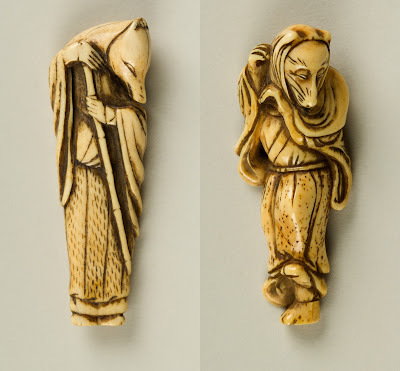 Two very typical katabori-netsuke made from ivory. Wood is most common but there are no rules for what material can be used, so figurines have also been made from metal and porcelain.
Two very typical katabori-netsuke made from ivory. Wood is most common but there are no rules for what material can be used, so figurines have also been made from metal and porcelain.For any serious religious ceremony or ritual to possess any form of legitimacy a monk troupe will have to be present. Whether praying before a battle, performing a marriage or a funeral, an Ape and a Pig will always be seated next to one another (the Ape on the right, the Pig on the left, representing their species’ roles in society as warriors and labourers) with the Fox figurine sitting in between them, and slightly in front. Should a Fox die, it would have no effect on the trio as his spiritual link to them would still be valid without his physical form.
When a Fox monk dies, he will be buried along with the effigies of all his Ape and Pig brethren. Should an Ape or a Pig die on the other hand, the survivor is expected to search for a new partner. Many spiritual men go through more than one partner, as the first one they encounter is often an old man who’s recently become incomplete. There have however existed some controversial individuals who refused to find a new partner, and instead opted for making an effigy of their dead Ape/Pig companion. These individuals are considered mavericks and reformers, and despite never having faced harassment, they were rarely taken serious as a proper Monk. These individuals have gone down in history, and folklore as lone spiritual men meditating alone alongside the effigies of their two dead brethren. Many of these live on as local folk heroes.
THE GREAT KARABU SPIRIT
The Ape Clan; Proud warriors, determined to protect the animal lands at all costs from their common enemy: They are the right hand of the great Karabu spirit ⁘ The Pig Clan; Gentle creatures dedicated to the maintenance and well-being of the clans: They are the left hand of the great Karabu spirit ⁘ The Fox Clan; The heart of the great Karabu spirit. They live in peace and tranquility, always meditating, always hoping for peace ⁘ Such is the harmony of the Animal Clans. - from the Wéydos Scrolls on Existence, Consciousness & Bliss.
The Animal Clans, though a very spiritual people, don't have a system of gods, per say, though in addition to a series of guardian spirits, they share a single, unifying figure representing the triad that holds the three clans together; the Great Karabu Spirits.
Also known as the many-faced spirit, the Great Karabu Spirit is the embodiment of the concept of the World Soul. Depictions of the spirit are traditionally featureless, showing only abstract outlines of the common characteristics of all three clans, such as two arms and legs, and a head commonly depicted with three blank faces (four in the first dynastic era). Usually made of wood, they bear no ornaments or identifiable carvings other than the depiction of a heart at the center. Each of its three core limbs representing the three core virtues of the clans as represented by the societal duties of the Apes, Pigs and Foxes.
These figures are the centerpiece of any clan shrine and is often prayed to for spiritual guidance. The Apes, f.ex. will often gather in their fort shrine to pray before battle.
When told to describe the great Karabu spirit the Fox elder Gotami of the 1st dynasty famously answered; “None.” There is no other and more appropriate description than this. The Karabu spirit does not possess any distinguishing features that can be described by words. By eliminating all differences, it becomes a symbol beyond all distinguishing marks such as name, action, species or allegiance. The Karabu is beyond specification as it represents the entire world soul. - from the Extended Discourses by Bala-Chatur Ō-Inari.
March 25, 2024
How a School Exam Became a Short Film
While rummaging through some old carboard boxes left in the back of a closet my mother recently discovered some old school documents I’d written long ago. One was an article dating back to 2008, my last year in Ungdomskolen—the Norwegian equivalent of High School, where I detailed the broad strokes of the history of time travel in fiction. Much to my surprise, however, stapled to the back of this report was a five-page short story simply titled The Time Loop.
 Hardly a masterpiece, but not terrible for something written by a Norwegian teenager in just a couple of hours.
Hardly a masterpiece, but not terrible for something written by a Norwegian teenager in just a couple of hours.It was written in English and was part of my final exam that year (I got an A if you were wondering). It tells the story of an Oxford student named Ian McDougal who is accidentally sent three decades forward in time while working on an experimental device being developed by an eccentric professor. In the future Ian stumbles upon a lecture being held on a now common teleportation device. He decides to steal one of these devices and take it back to the present, figuring it will make him a rich man. The lecturer, who’s also the inventor if this device, catches him in the act and chases after him. Ian succeeds in getting back to the time machine and subsequently back to the present with the stolen device. In the following years he claims the device as his own invention, patents the idea, and becomes one of the richest men in the world. Then, one day thirty years after his time travel incident, while lecturing at his old university he sees someone trying to steal his device, chases after him, only to realise that the young man is his younger self, thereby bring the circle of events to a final close.
Fourteen years after I wrote this story, in December of 2022, I released a short film on my YouTube channel titled Paradox, which, if you’ve already seen it, you might have recognised that the plot I described above is nearly identical to the plot of this short.
This is obviously no coincidence, though you might be surprised to know that until this recent rediscovery by my mother, I was convinced this document had been lost.
Paradox actually started in late 2018 at the London Film Academy, when I was encouraged by the joint principal, Daisy Gili, to write and direct a 10-15 min. short film that would be co-produced by the school. I was at the time getting ready to travel back home to Norway in just a few days and would have to hand in a script before leaving. This didn’t give me much time to come up with a story. Luckily, I remembered the basic plot of The Time Loop, and the following day I handed her the first draft of the script. Ian was now Morgan, Oxford was changed to London, but all the story beats remained pretty much the same. She was pleased with the script and felt it was doable with the agreed budget, so we set a date for the following year when I would return to London to shoot the film.
The shoot itself went quite well, but the post-production can only be described as one of the most frustrating things I have been through. I will keep it short, but suffice it to say that Covid-19 caused many delays and that I did not get a proper “final” cut done until early 2021. Initial screenings to friends and family forced me to admit that I’d made a pretty serious casting error and the following year I decided to reshoot every scene with the middle-aged version of the protagonist, a process requiring multiple green-screen set-ups in London (which was shot by a second unit), something which created many time consuming VFX shots, and the final film was not completed until December 2022. Keep in mind that during the more than three years that had passed between the shoot and the final release, I had written a whole novel, started work on two more, not to mention written, produced, shot, edited and released a whole other short film a few months earlier that year. It’s safe to say that this is by far the longest I have ever worked on a single story—for better and for worse.
Despite all this, I must say it was a fun experience finally getting to hold the original short story in my hands and being able to read the original idea for the first time in sixteen years (even if the writing wasn't very good).
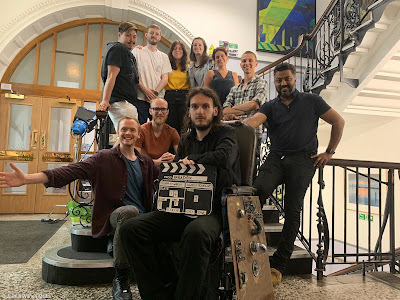 Crew photo (plus leading man Perry Jaques) on wrap day in August 2019.
Crew photo (plus leading man Perry Jaques) on wrap day in August 2019.
March 23, 2024
Dawn of the Karabu Lore: The Children of the Light
The following text is taken from a "fact sheet" I made to assist me during the writing process of what would become my 2020 novel, Dawn of the Karabu . This first part is a summary of the culture, religion, social hierarchy and geography related to the faction known as The Children of the Light, of which the novel's main character is a part of.
Whether this is merely a reminder or your first time reading about the world of my novel, I hope you will find it interesting.
NOTE: No story spoilers have been included in this first part. The text has also been partially altered and updated from the original due to fix some minor incongruities between the final novel and the original document. Most of the reference photos originally used had to be removed for copyright reasons and have been replaced with stock images.

Before the Light, there was darkness ⁘ And the darkness is Karabu; the man-beast- from the Book of Ascension, Chapter I, Verses 1-2.
THE TRANSCENDED as seen by the humans
The Transcended, now referred to as Legion, are the humans of the past who achieved perfection of both body and mind and evolved beyond the physical form into beings of pure thought and energy; Enlightened beings.
The first humans who transcended wished to share their achievement with the lower human forms and made a religion to aid them in achieving enlightenment. They created the cycle of rebirth and the caste system to encourage humans in their quest for perfection and transcendence. Those who work against it are punished by being reborn in lower forms, and those who achieved perfection are allowed to keep it in the next life.
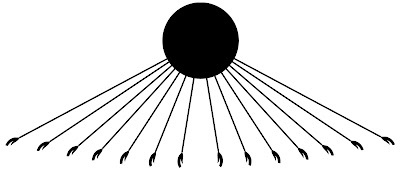 A common symbol depicting the many helping hands of Legion.
A common symbol depicting the many helping hands of Legion.
Before the first transcended beings there was a war of conflicting ideals. Some humans perversely wanted to return to animal form and even uplifted the animals by giving them human qualities. This perversion of perfection angered the humans striving for perfection and war broke out. The war was eventually won as the transcended moved beyond physical form. Those who supported the Transcended were rewarded with karma and rebirth so that they could also one day achieve perfection. The enemy was punished by removing their ability to gain good karma, but nonetheless cursed with rebirth. They will forever be reborn as the animalistic abominations that they created.
Herein lies the Animal Clans’ contempt for humanity and their perfection.
Before the doctrine of Light, yet after the age of the Beast, there was the Talos ⁘ The Talos rejected the darkness, but the Light was yet out of reach: and they pondered on matters of transcendence for centuries ⁘ The age of Light began when the Talos, once many, became One: Legion ⁘ Light and Mind became One, formless and pure
- from the Book of Ascension, Chapter II, Verses 1-2,4-5.
A karma-based spirituality that teaches that your caste is determined by your accomplishments in your previous life.
The High-Caste is the reborn form of previous members of the Middle-Caste who strived for perfection and transcendence. The beauty, strength and intellect gained through their hard work is rewarded as a permanent feature in the next life. Thus, they retain their achievements of perfection in birth, unless they commit sin or embrace non-perfection. Then they will be reborn in a lower caste.
The Middle-Caste consists of the neutral individuals who neither deserved reward nor punishment for their past deeds. Their past life was one of indifference towards perfection. Thus, one remains in the middle.
The Untouchables consists of those who have been punished for past evils and have therefore been given animalistic features and must work hard to redeem themselves. In their past lives they stood in the way of perfection or broke the holy laws. Their punishment is slavery and the shame of being cursed with animalistic aspects. By living up to their caste's responsibilities and hard work they will be reborn in the Middle-Caste after an honourable death.
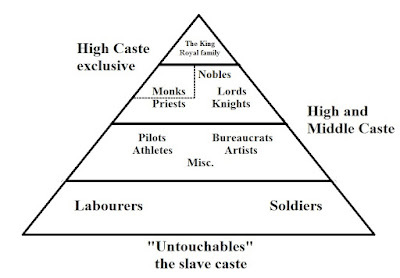 A simple breakdown of the hierarchy of the Children of the Light.
A simple breakdown of the hierarchy of the Children of the Light.Then Legion spoke unto man and said; grieve not, for Transcendence will be thy legacy, and our teaching ⁘ Thou shalt reject the darkness, and embrace the Light: that is perfection of thy mind and body ⁘ All that is dark shall remain dark, and all that is Light shall remain Light ⁘ Though the task be difficult, thou shalt be blessed by death temporary, and thou shalt live again until purity of body and mind is achieved ⁘ Then Legion went silent: And thusly the doctrine of Light was founded - from the Book of Ascension, Chapter III, Verses 2-5, 8.
THE HIGH-CASTE
They are the most genetically perfect among the human castes. Possessing the highest achievable physical form, they are the highest of the earthbound states of being. In addition to extreme physical beauty, they are stronger and more intelligent than the other castes. Their aging process is considerably slowed down, and a youthful appearance is maintained until death. The average life expectancy for those in the High-Caste is about 200 years. Only the loss of hair colour (into silver grey) and some level of strength and vitality separate the old from adult.
ClassesThough simple soldiering is reserved for the Untouchables, it is common for High-Caste individuals to become Knights and Pilots. There are many classes(/occupations) available for the Highest Caste, most of which are also available for the Middle-Caste:
Monks are the most revered and respected members of the caste. Only the genetically perfect are allowed to seek final transcendence.
Priesthood is a very prestigious position in society. Unlike the Monkhood it is possible for Middle-Caste members to teach the gospel.
Knighthood is the most popular and prestigious position in society. Knights are commonly former athletes or pilots. Only a member of the royal family can grant the title of Knight, and it is not uncommon for Middle-Caste member to be awarded this title. The Knights serve under the King or Queen as the generals and military strategists of the royal army. They are easily identified by their polished steel-plate armour, commonly forged to accentuated the shape of their athletic bodies. The higher the rank, the more ornate and elaborate the designs will be. The image of the brave Knight in shining armour is one of the most enduring symbols of the Children of the Light.
Pilots consist of the best athletes and intellectuals of society. Like Knighthood itis not uncommon for Middle-Caste members to become pilots. As piloting requires intellect and skill, rather than brute strength, it is a revered skill to be able to pilot a fighter jet. It is worth noting is that piloting is a field overrepresented by women. Pilots are identified by their dark-blue coatee dress-uniforms when off-duty. Otherwise they are usually seen wearing somewhat bulky, but practical flight suits. Higher ranking officers, such as Captains, do not have to adhere to any dress code and are generally more elaborately dressed, often embellishing their fashionable outfits with their medals. Cadets refer to this as "Captain's privilege." Only the golden epaulettes that signify their rank are mandatory.
Athletes consist of the fittest members of both the High and Middle-Caste. Athletes are more or less celebrities in society, always competing to entertain the masses. The class exist as a testament to the virtue of the individual’s journey to perfection. It serves as both entertainment and as encouragement to the masses. Most athletes become Knights or pilots, many become actors. It is uncommon for someone to remain an Athlete more than a decade or so.
Magistrates are the head of the law in each respected region and is attainable by both High and Middle castes.
Archons are powerful nobles who operate as provincial governors. Although the position is achievable by both upper castes it is rare for a Middle-Caste member to reach such a status. The Archons rule their respective regions according to the law and answer only to the King, and the Grand Archon council in the Capital city.
Companions are men and women who act as hosts and whose skills include performing various arts such as classical music, dance, games, conversation, sex, and religious rituals for individuals of high standing. The qualifications for becoming Companions are very high, both in terms of education and physical attractiveness, and as a result Companions are nearly exclusively High-Caste.
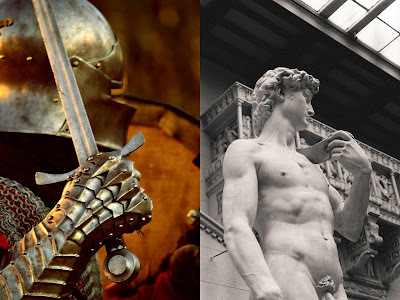 Nearly every aspect of their society is a celebration of the human body and spirit.
Nearly every aspect of their society is a celebration of the human body and spirit.You who are willing to die, I salute you ⁘ You who sacrifice thy body, I salute you ⁘ I who salute you, will be honored to be thy Mara; thy death and rebirth incarnate ⁘ I am honored to guide thy body on its journey to perfection through death temporary - selected excerpts from the lengthy Marana ritual, generally performed on the eve of battle (provided a Companion was available).
THE ROYAL FAMILY
The current head of the Royal family is the King Regent Ozymandias II, the third ruler of the Nineteenth Dynasty (also know as the "Modern Era"), son of Menmaatre I, and grandson of Ozymandias I; also known as "The Pilot King" or "The Aviator."
His wife, the Queen Amarantham (“eternally beautiful”), comes from High-Caste Nobility. She is a veritable fashion icon and is considered to be the epitome of the “Modern Woman.” She is often used in propaganda as the symbol of High-Caste purity. When it became apparent that Amarantham (nicknamed “Amara”) was being courted by the Prince Regent Ozymandias, there came forth a lot of speculation regarding her distinct purple-coloured eyes. Some argued that such an unusual colour must be the result of a genetic mutation, ergo an imperfection, spurring much religious and scientific debate. While the Monks and Priests tirelessly argued over what she might have done in a previous life to deserve an imperfection despite her High-Caste, the scientists were scratching their heads over how such an abnormality could have occurred among the High-Caste to begin with. After much deliberation, it was eventually concluded that her purple eyes were in fact not a mutation, nor a karma punishment, but rather a rare and unique sign of beauty, which in fact only made her even more perfect than most people. Her fans even started to describe her eyes as “The Queen’s Blessing” implying that she’d been unusually perfect and pure in her past life. A popular rumour even suggested that she might actually be the reincarnation of the mythical Aglea; the First Queen. She is often referred to as Callisto; the “most beautiful.”
THE MIDDLE-CASTE
The Middle-Caste consists of ordinary humans without any form of genetic improvements. They are practically identical to the humans of the pre-enlightenment past, possessing average lifespans, physical strength, intellect, and beauty.
Individual improvement is key to the Middle-Caste as the strongest, prettiest, and smartest individuals get rewarded with distinctions in society. Those who live up to the perfection of the High-Caste has their caste restrictions removed and can even become Knights and Priests. Although the Middle-Caste acknowledges their imperfections, they revel in the opportunity to improve and transcend. Middle-Caste individuals must be accepted by the High-Caste in order to enter their settlements/cities and live with them.
The Middle-Caste lives in towns and small villages. They enjoy a much more simple and natural lifestyle than those living in the cities. The elevated members however tend to live in the capital city, unless they return to rule as local Governors, Magistrates or Priests.
High-Caste members have unlimited access to Middle-Caste settlements and must be treated with reverence. Unlike the Untouchables, the elderly do not have to hide from the High-Caste but must treat them with the utmost respect.
Their past life was one of indifference towards perfection ⁘ Thus one remains in the middle
THE UNTOUCHABLES
“The Untouchables” are the lowest of the human castes. They are the descendants of the humans who, in the ancient past, altered themselves with long forgotten dark arts to have the abilities of certain animals. A side effect of these abilities is a degree of animalistic appearance and behaviour. Being the furthest away from achieving physical perfection they are stigmatised in human society and perceived as a lower form of humans. In fact, they are barely considered human at all.
In their past lives they stood in the way of perfection or broke the holy laws ⁘ Their punishment is to labour all their days and to live with the shame of their grotesque forms ⁘ By fulfilling their caste responsibilities they will be reborn in the Middle after an honourable death
- excerpt regarding the Untouchables from the Helios Praxis.Classes
The caste is divided into two groups; Warriors and Labourers.
The Warrior Class is always required to always wear their armour while on duty to spare their superiors of their animalistic appearance. Their animalistic features depend on their role in the military.
The Foot soldiers have the higher muscle density, agility & aggressiveness from chimpanzees. They possess mammalian Endotherma as well as the 340-degree eyesight of goats. They are hairy to the point of having fur and their eyes are noticeably goat like.
The Berserkers have the higher muscle density of gorillas and the extreme aggression of baboons and boars. They too are extremely hairy. Many of them are known to grow tusks.
The Sharpshooters have the heightened eyesight of eagles and the night-vision of owls. They possess large birdlike eyes.
The Assassins have the sonar abilities of bats, night-vision from felines, Poikilotherma from snakes and the camouflage of octopi. They have noticeably feline eyes and grey skin.
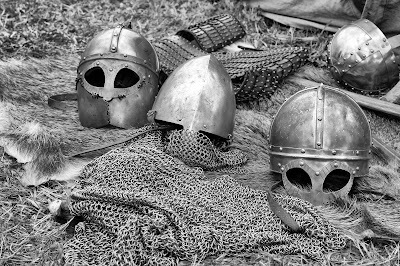 It is considered shameful for an Untouchable to be seen without helm or face covering, especially by a member of the High-Caste.
It is considered shameful for an Untouchable to be seen without helm or face covering, especially by a member of the High-Caste.The Untouchables are sometimes given the derogatory nickname “Karabu”, a reference to a heathen mythological character of the past that embodied both human and animal features. Many people, especially those that are particularly religious, believe the Untouchables to be a curse upon humanity for their impure past.
Among the animal clans however, the Untouchables are referred to as “Lumasi” (“Apsasû” in the case of the females) their own reference to ancient gods that combined human and animal features. To the Animal Clans the Untouchables are seen as respectable beings.
TECHNOLOGY
The beginning of the Nineteenth Dynasty marked more than just a change of royal family, but proved to be the beginning of the Children of the Light's industrial age. As a society focus on perfecting the body and soul, as well as being deeply traditionalist and cautious off anything that might resemble the technological monstrosities created during the fabled Age of the Talos, innovation has generally been slow. This all changed after the coronation of King Ozymandias I, the so-called "Pilot King," who uncharacteristic of his forebears, had a strong passion for technology, particularly aviation. A bit of a rogue in his days he sought inspiration from the birds, an idea which initially drew criticism for glorifying the features of a lesser being; a beast of the wild, with many sceptics arguing that the new regent was flirting with the evils of the mythic Karabu King during the pre-enlightenment age who consorted with the Animal Clans. But Ozymandias rejected such claims, being more interested in the mechanics and physics of bird wings, arguing that such a boon must be replicated by humanity in order to truly claim to be the superior being.
The King eventually succeeded in creating the first aeroplane, an innovation which was quickly adapted by the military for use against the Animal Clans, giving them, for the first time in centuries, the upper hand in the war.
Following this invention, Helios and the regions around, it quickly entered the early stages of an industrial revolution which quickly produced everything from advanced firearms—a huge improvement to the crude flint-locks used previously—to the first automobiles. Soon followed other inventions such as radio and photography, both of which were quickly embraced by the relatively new Ministry of Propaganda (an off-shot of the much older Inquisitorius) which had mostly kept a watch over the printing press for the past few centuries.
The son of Ozymandias I, Menmaatre I, did not share his father's passion for technology, but was wise enough to never actively discourage innovation, a tradition maintained by his son, the current ruler; Ozymandias II. In the centuries since his grandfather, aviation has blossomed into a bona fide armada which stands in stark contrast to the still traditionalist army of Grunt Soldiers and Knights who still operate much according to tradition, often charging into battle on horseback armed with a sword and a pistol.
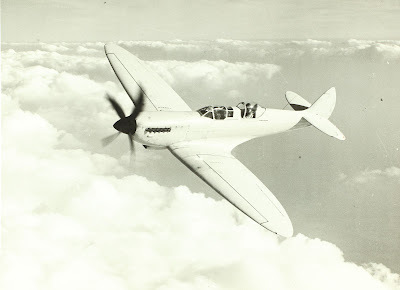 Despite the still primitive technology of the Animal Clans, they quickly devised clever anti-air measures that continues to make aviation nearly as dangerous as being a ground trooper.
Despite the still primitive technology of the Animal Clans, they quickly devised clever anti-air measures that continues to make aviation nearly as dangerous as being a ground trooper.GEOGRAPHY
The Seven Regions
The land of the Children of the Light is divided into seven regions.
Helios is the smallest but most important region, known for housing the capital city of Heliopolis. The land surrounding the great marble city is primarily made out of plains, they it borders on the shrublands near the borders to the Animal Regions. Helios enjoys a humid subtropical climate. The people that reside here are referred to as the Helosians and are primarily High-Caste.
Hyksos borders with Helios to the north. The land here is lush and tropical, with the southern regions consisting of the same plains that stretch down to Helios. The culture here is very much an extension of Helios and is a popular place for the ruling elite to establish their villas away from the capital city. The people that reside here are referred to as the Hyksonians and are primarily High-Caste. The capital city of Hyksos is called Avaris.
Byblos (meaning "Well of the Gods") borders with Helios to the west and is the region that borders with the strip of desert that separates the Children of the Light from the Animal Clans. The environment here is mostly shrublands, arid plains, mountains and some grasslands near the Helosian border. The people that live here are called Byblosians and has at all times a roughly 70/30% divide between High and Middle-Caste. The majority of the military, not counting the cadets of the capital city, are located somewhere in Byblos, either residing in one of the border cities or stationed in one of the many permanent military forts. The capital city is the ancient walled settlement of Tanagra.
Argolis is another fairly small region which borders with Byblos to the north-west, Helios to the north, and Edonis to the south. The climate is mild, bordering on temperate and the land consists mostly of grasslands. Like the region of Edonis a large percentage of the region is farmland, however, it's most famous export is technology. Due its close locations to the military settlements in Byblos, while also having land more suited for agriculture, which also makes it self-sustainable, it has become the centre of most weapons manufacture and military research. Much of this research is highly classified, making many of the settlements insular communities consisting of researchers and their families sworn to secrecy. It is as such one of the least recreationally visited regions, with the exception of the Outlaying Regions. The farmlands here also cater to the settlements of Byblos and to a lesser degree, Helios. The people here are referred to as Argosians and are primarily High-Caste. The capital city is called Argo.
Harari is one of the largest regions and lies to the north-east of Helios, almost as far away from the capital to the east as the Outlaying Regions are to the south, making it one of the more distinct regions. The population here is primarily dark skinned rather than the bronze hues of the Helosians and Hyksonians or the pale skin of the people of the southern regions. The climate is similar to the northern parts of Hyksos, being primarily tropical. The people here are referred to as Hararians and are primarily Middle-Caste. The capital city of Harari is called Harar.
Edonis is located south of Argolis and borders with the Outlaying Regions in the south. The climate is temperate and the land mostly consists of grasslands and forests, making it the most agricultural of the seven regions. It has the largest percentage of farmland and is the source of most imported produce. The people here are referred to as Edonisians and are primarily Middle-Caste.
The Outlaying Regions, officially named Memnon, is the oldest of the seven regions, and is known for its many ruins dating back to the pre-enlightenment age, during which it was named Achoris. It was once under the rule of the infamous Karabu King, the last king of the blasphemous union between man and beast before Aglea the blessed became the first queen of the first dynasty and founded her new kingdom in Helios. The most famous ruins are the Two Colossi and the ruins of Abydos (former capital of the Karabu King). The climate is fairly temperate, with cold winters and mild summers. The landscape is mostly mountainous and has limited vegetation (though the norther parts bordering with Edonis is mostly grasslands and forests), resulting in scattered settlements with makes this the poorest and least technologically advanced of the seven regions. It is the only region which borders the great ocean to the south-west. The largest city, which is generally treated as the capital, is called Luxor. The name means "fortified camp" suggesting it was once a military outpost. The people that lives here are almost exclusively Middle-Caste and there is only a tiny population of Untouchables, who mostly acts as private servants to the few magistrates and archons who reside here.
The Capital of Heliopolis
The most important members of the High-Caste live in the capital city of Heliopolis (meaning “City of the Sun”). It is located not far from the desert borders and lies east of the majority to the Middle-Caste settlements.
The capital of Heliopolis is a marvellous marble city. The splendour and white marble stand as a testament to the glory and purity of those who have achieved physical perfection. The city exists as a celebration of this accomplishment. No member of the transgenic caste can enter the city unless they’ve performed a cleansing ritual and wear full body suits at all times. Even Middle-Caste individuals that have not been granted permanent citizenship must partake in a minor washing ritual before entering the gates. The city’s most important function is as the location of the Royal House and for housing all the major political centres representing all the human castes.
 The city is often referred to as the "Great Marble City," in reference to its white pinnacles which can be seen coruscating in the light of the sun from many miles away.
The city is often referred to as the "Great Marble City," in reference to its white pinnacles which can be seen coruscating in the light of the sun from many miles away.Tanagra & The Border Cities
A minority of High-Caste members consisting mostly of Knights and Pilots, as well as their families, live alongside Middle-Caste citizens, also mostly Knights and Pilots, in the border cities near the military forts that guard the edge of the desert strip that serves as a neutral zone between the land of the Children of the Light and the Animal Clans. These moderately large population centres are all located within exactly 20km from a fort.These cities are infamous for their large populations of Untouchables who serve as both grunt soldiers and labourers. Every border city has their own unique “grunt quarters” which, rather than being separated from the main settlement, surrounds the High/Middle-Caste quarters to serve as protection in case of an attack. In such a situation the grunt soldiers will protect the outer walls, while the High and Middle-Caste Knights will hold the centre. Although no Apes have gotten near a border city in centuries, it has in the past proved an effective method to limited High and Middle-Caste casualties.
The oldest, largest, and most famous of these border cities is called Tanagra. Built during the first dynasty it is the template from which the other border cities were based. The nearest military fort, which relies on Tanagra for supplies and reinforcements, is called Fort Hadrian.
The Desert Strip, The Shield Wall & The Forbidden Lands
This thin strip of desert, roughly 40km across, pours out from a gap in the great Eukyklos mountain range, colloquially referred to as the Shield Wall, that protects the lands of the Children of the Light, as well as the lands of the Animal Clans, from the toxic desert of the Forbidden Lands that was once the domain of the Talos in the pre-enlightenment age. Little is known of the toxic desert other than what is told in myth and legend. All that is truly known is that it is a barren land in which the very air itself is so poisonous that no living thing can survive there. As for legend, it is said that giants roam the desert; automaton left behind by the Talos. They exist now for a single purpose; to pull apart and moulder the materials of the once great cities of the forgotten age so that no token of their dark crafts can corrupt the Children of the Light.
From a gap in the Shield Wall, said to have been blasted by the mythic weapons of the ancient Talos, the sand has poured out over the centuries, creating a 'strip' of arid desert that reaches all the way to the sea. Unlike the toxic desert it can be crossed, though like any desert, it is barren and inhospitable. It has effectively served as a border between the Children of the Light and the Animal Clans for several thousand years, though at times in the past land has been occupied on either side.
Each side of the desert is guarded by strategically placed military forts and look-out posts.
> Much blood has been absorbed into the sands of the Desert Strip which have served as battleground for untold millennia.
Much blood has been absorbed into the sands of the Desert Strip which have served as battleground for untold millennia. Cliff Town
The easternmost of the villages in the Outlaying Regions, "Cliff Town" rests about 2km from the edge of the cliffs alongside the coast. About 50km north of the village lays the eastern mountain range connecting to the desert neutral zone.
Although the Apes haven’t attacked by seaway in several centuries the Town and its smaller outlying villages still man and maintain the old Cliffside cannons. Although the population is fairly small it could hold back a large-scale attack for weeks due to the dangerous reeves and the hard to climb cliffs. Even so, any large-scale navy would be spotted by the northern mountain villages along the coast well in advance. Cliff Town also has a decently large airstrip and enough fighter jets to do massive damage to an attacking fleet.
The beach at the bottom of the eponymous cliffs are lined with ancient statues depicting monstrous chimeras. They have stood for so long that most have worn down beyond recognition, appearing almost as natural rock formations.
 The cold, misty mountains of the Outlaying Regions stand in harsh contrast to the warm and sunny flatlands generally associated with the Children of the Light.
The cold, misty mountains of the Outlaying Regions stand in harsh contrast to the warm and sunny flatlands generally associated with the Children of the Light.And it is here the story of the Dawn of the Karabu begins, with a young Middle-Caste pilot on the day of her ascension; the day of her acceptance into the military academy in Heliopolis.
However long the night, the dawn will break.
- from the Helios Praxis.
CONTINUED IN PART TWO: THE ANIMAL CLANS (coming soon).
March 11, 2024
Making the Book Trailer for The Starseed
NOTE: This article references the full-length book trailer for The Starseed in a way that assumes you are already familiar with it. If you have not seen it, or if you'd like to re-familiarise yourself with the video, you can do so by clicking HERE.
INTRODUCTION
My biggest passion as a creative person has always been filmmaking. Although I did write fiction as a child, I was not much of an avid reader until later, and once I started making amateur films with my friends at age 12 it quickly became apparent to me that I wanted to be a filmmaker.
Of course, filmmaking, even in its simplest form is still an expensive and labour-intensive process requiring a fair amount of people, and the fact that I’m drawn towards sci-fi, fantasy and historical fiction hasn’t exactly made things easier.
In this case literature has been a real blessing for me. Granted, making a novel isn’t exactly free, especially if you want it to be up to professional standards. Though in the case of The Starseed I managed to save some money by designing the cover myself—one of the many benefits of a Media & Communications education. But,compared to a making a film, writing a novel is about as financially freeing as it can be, and you are only limited by your imagination. There are no actors’ fees, no location permits, no props, no sets. If you can write it, the audience can (hopefully) imagine it.
Of course, a book still requires some marketing if you want people to become aware of it. So, I decided to put some of my filmmaking skills to good use and make a book trailer. Most trailers that are out there, even the “professional” ones, are in my opinion, quite lacklustre, often relying on bland stock footage. I wanted to make something that would stand out.
THE CONCEPTI was still working the novel when I started work on the trailer (final rewrites, spell checks, fact checks, that sort of thing), and not wanting to distract myself too much from finishing the very thing I was going to market, I decided to avoid anything that could accidentally turn it into an expensive short film. I therefore decided to make the video entirely out of still images, something which also had the added benefit of making it unlikely that it would be mistaken for a trailer for an actual film. Stills of real people and locations would provide me with a certain degree of authenticity, but it would be different enough to not give a false impression of the “product” I was advertising.
Naturally, as often is the case with any creative process, I started with many different ideas, some good, some bad, not to mention some very ambitious, until out of discipline and, unfortunately, in some cases, out of plain bad luck, I eventually managed to whittle it all down to something simple and surmountable.
GOING ANALOGUEI have always been a sucker for the analogue aesthetic. Digital technology has served me well in the past (and still do), and I would not have been able to do most of my short film work without it, but there is simply something special about celluloid film. I have been fortunate enough to have shot one of my short films at the London Film Academy on super 16mm film, and I very much hope to one day be able to upgrade to full 35mm film as I genuinely see it as the superior medium for filmmaking. There is simply a richness to the colours, a depth in the collection of silver crystals, a sharpness of the interplay between light and shadow that simply cannot be fully emulated digitally. Of course, digital video has reached a level of quality that makes it a more than worthy alternative, though I am adamant that it is not a substitute.
However, for this book trailer 35mm film provided me with several benefits, and in this case it did admittedly have very little to do with image quality. Here it was simply a case of instant authenticity. I have several SLR cameras, all of which belonged to my mother, ranging from the simple to the complex. For practical reasons I went with complex and chose to use two Canon SLR cameras from the late 80s. Not entirely authentic to 1975, but I did not want to risk anything going wrong with the “cheaper” cameras from the 70s. I knew I would have to be economic with my 35mmfilm, though my initial, and frankly naïve, assumption that I could pull off the entire trailer with just one roll of film quickly escalated to four.
 My Canon EOS 650 & Canon EOS 5 cameras.
My Canon EOS 650 & Canon EOS 5 cameras.
FINDING PROFESSOR KORRIGAN
I had originally planned to find local actors, models, or just anyone who was willing to be photographed, to portray allof my main characters, not just Professor Korrigan, but Marshall, Hagen, and even Bergström as well. Suffice it to say that this didn’t work out, so I was forced to simplify things to just Korrigan.
That solved three problems, but still left me with the most important one, and a big one at that; where do I find someone in the Stavanger region that looks like an English professor with an Imperial moustache? I actually considered buying, or even commissioning, a fake moustache at some point, but I was sure that I had seen someone with an appropriate moustache locally. But where? And when? I searched and I searched, and at one point, through a friend who knows a lot of interesting people, I seemed to have found a near-perfect match; a true anglophile who could provide me with not only the moustache, but tweeds, hats, pipes, the whole works. Unfortunately, he had just taken ill and declined my offer. After more futile searching I decided to call someone I knew personally. He was a far cry from the dandy Englishman I pictured in my head, but he did have a moustache that was close-enough, and being a local actor who worked for a revue he could provide me with his own costumes. I asked him and he was willing to take sometime off to pose for me. I counted my blessings. At that point I considered this a huge victory in a project that had been nothing but setbacks and compromises.
Though I was, and still am, extremely grateful for his willingness to support this project, I must admit that the end result was such a far cry from what I had imagined while writing the book that I somewhat despondently carried on with the project worrying that the first official depiction of my new recurring character would be so unfaithful to the book—and done by myself no less! Shortly after, however, my salvation finally came in the form of a poster.
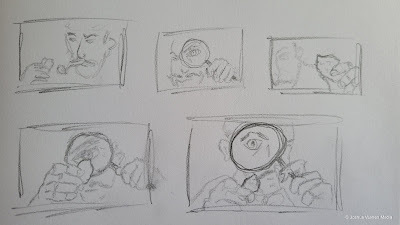 Some crude "storyboard" sketches for the Professor Korrigan photoshoot.
Some crude "storyboard" sketches for the Professor Korrigan photoshoot.Every year, in the town of Bryne where I live, they have a festival called Potetfestivalen (literally translated as “The Potato Festival”). And at the very top of the posters littered all over the town to inform of the upcoming activities was a photo of a man that immediately made me think; “that’s Korrigan!” Granted, an English gentleman like Korrigan would never be caught dead wearing a plaid shirt and a baseball cap with a picture of an anthropomorphised potato on it, but the slim face, the hawk-like nose, the dark-grey hair, and of course, the moustache, was perfect. With some help from the people running the festival I managed to track down the man on the poster, contacted him, and was thrilled to hear that he was willing to be the face of Professor Korrigan.
His name is Arne Vagle. He is a specialist in grains and potatoes working for the Norwegian Agricultural Advisory Service in Rogaland, and once I had learned of who he was, it quickly dawned on me that I had seen him many times before and that he was most definitely the moustached local man that I previously alluded to. It turns out that Vagle has been present at every Potato Festival since its creation in 1998, where he always presents a colourful assortment of different kinds of potatoes. Although I am admittedly not much of a connoisseur of potatoes, I had definitely seen him at the festival before and had clearly made some mental note of his distinguishable stache that had partially reemerged at the start of this project.
I met Vagle at his office and decorated one of the walls there with a cheap green tarp I had bought the day before to imply that he was sitting within a tent as a part of the archaeological excavation described in the book’s first chapter. After I had snapped a series of photographs here, I asked him if there was a basement or something to that effect that could be used to represent the machine room of the LNG tanker from the opposite end of the book, and he took me down to a locker room with a large metal cabinet and some air vents that that made for a passable backdrop. These photos, taken more-or-less in the dark, came out a little fuzzy, but that only enhanced the moody and grimy look that I wanted.
 Two unused photos of Arne Vagle in costume.
Two unused photos of Arne Vagle in costume.There’s not too much to say about the costume Vagle wore. The tweed jacket I found at a 2nd hand store, and the rest was common enough. The pipe and the potsherd on the other hand are both very special and carry a bit of personal history.
The pipe belonged to my great grandfather and has been in the possession of my mother ever since he passed away in the1970s. In fact, he had several pipes, two classic bent apple ones, a steel tipped jet pipe, and a foldable vest-pocket one for travel. I chose one of the two classical ones, favouring the one with the most noticeable signs of use as it seemed the most suitable for my well-travelled professor.
The piece being examined by Korrigan is part of a collection of real Native American potsherds found in the Arizona desert by my mother in the early 90’s shortly before I was born. Most of these sherds, which have always been on display in my mother’s living room for as long as I can remember, wouldn’t pass for Viking-era pottery, so I chose one of the most neutral ones. My mother, like myself, has always been quite fascinated by history and archaeology, so when I showed her the original photos I took she quickly reminded me that an expert on ancient pottery would focus on the cross-section of the rim in order to determine the overall shape and size, and thereby also the style and era, of the original pot. So, when I later handed the piece to Vagle, I made sure to relay this information to him.
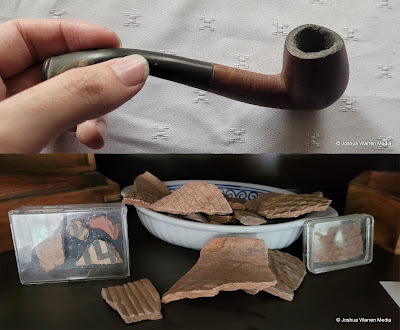 My great-grandfather's pipe and my mother's collection of Native American potsherds.
My great-grandfather's pipe and my mother's collection of Native American potsherds.BUILDING A CRIB ON A BUDGET
I knew early on that the ominous note left behind in the crib by the eco-terrorists would be an important visual motif in the trailer, so it was clear from the beginning that I would have to recreate the photo that Special Agent Marshall hands Professor Korrigan during their first meeting at the start of the book.
The note itself wasn’t a problem, and my mother provided me with the little teddy bear you can see in the top left corner. But what about the crib itself? I didn’t want to spend time and money buying a whole crib, let alone a vintage one, just for a single photo. The answer was a clever no-budget solution I had picked up at the London Film Academy. For a scene set in a prison cell, the director of photography had the clever idea to create the illusion of a barred window by stretching some black electrical tape over an empty frame that we held up to the light, thereby casting long vertical shadows over the actors. For the trailer photo I simply put a bedsheet over a rectangular foam pad, placed the note, the teddy bear, and a blanket that my mother had kept since I was a baby on top of it, then held a metal frame with a few rows of black tape in front of the window on a bright autumn day and snapped my photo.
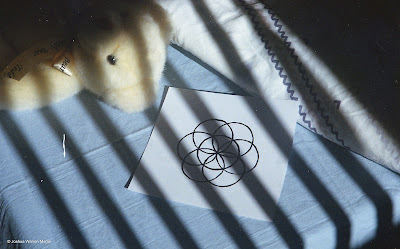 Rejected photo where the illusion of a crib doesn't quite work.
Rejected photo where the illusion of a crib doesn't quite work.AN AMERICAN CAR IN NORWAY
I also wanted to actually show the arrival of Marshall at the excavation, the latter of which I knew would have to be represented with a simple stock image which I eventually acquired through the archive at the University in Stavanger. As for the agent himself, since my original plan to include several actors/models never panned out, I decided instead to emphasise the mystery of the situation and figured that his foot stepping out of the car would suffice. The foot, if you were wondering, is mine.
But what of the car? I had a foot (and oneto spare), I had some reasonably appropriate footwear, and I could easily find a rural spot to shoot the scene in (there’s plenty of those in Jæren), but you might think that vintage American cars aren't exactly something that everyone has in their garage. Lucky for me, however, I live in the Norwegian countryside, a place practicality riddled with American car enthusiasts. The largest organised group is called Amcar (quite simply short for “American car”). I contacted the local branch and gave a general sense of the type of car I was looking, deciding that this was not a time to be picky about exact models.
I eventually met up with Terje Tytland, the owner of a beautiful1970 Ford Lincoln Continental. Though fairly different from the Chrysler described in the book, it did have that elongated and blocky silhouette that just screamed early 70s. If Marshall hadn’t gone for the Dodge Polara, this might have been his second choice. So, on an appropriately overcast day we took the car out to a country road where I snapped a few pictures of the car and he snapped a few of me stepping out of it.
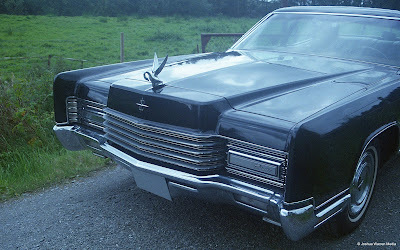 A closer shot of the Ford Lincoln Continental that was not used in the trailer.
A closer shot of the Ford Lincoln Continental that was not used in the trailer.OILY GEODES
The meteorite shown in the trailer was another lucky no-budget solution. In 2008, while visiting some friends in the US, we went geode hunting in a stream in Illinois. During the drive we were given a rundown of what we might find—our “guides” had done this sort of thing many times before and had practically become experts—and explained that there were supposedly some geodes that contained raw oil, though they had never seen this. We hiked down to the stream, found several stones of varying sizes, cracked a few open, but one proved particularly tough, so we brought it back to our friends’ house and later that evening we took turns trying to break it open. The hammer passed from person to person, sparks literally flew from the rock as the hammer hit it, and eventually, as if it finally yielded to our curiosity, it neatly divided into two almost equally sized halves and a glob of black liquid splotched onto the pavement. It was actually filled with oil! You can still see dried up oil in the cracks of the odd, almost organic-looking interior of this strange geode, and we were told that the larger oil stain remained visible on the pavement for the better part of a year after we’d left.
Although the coarse, grey surface of this river rock is technically another incongruity with the novel, where it’s described as a smooth obsidian-like stone, it did fit most people’s preconception of what a meteorite should look like, and with its weird-looking interior revealed in cross-section, I decided to once again not squander a good opportunity with nitpicking.
The basement of my mother’s workplace just so happened to still have a bunch of furniture and random bits of equipment from the 70s and 80s scattered about, and provided a perfect backdrop for the scene where Bergström, also played by me, sneaks into the geology lab of the drill rig and places the stone on the table. Likewise, the rusty metal floor seen in the background when the stone is picked up (this time by my mother) was simply a small landing between two stairs near a restaurant a few blocks away from where I live that I felt had a nice industrial look to it. Yet another simple no-budget solution.
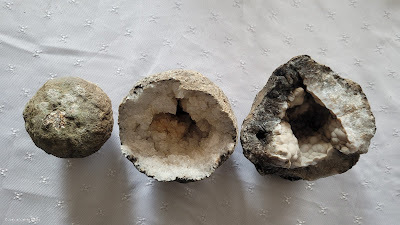 A normal river stone, a common geode, and a not so common geode. The black marks on the geode on the right are what's left of the crude oil.
A normal river stone, a common geode, and a not so common geode. The black marks on the geode on the right are what's left of the crude oil.THE CHILD
The last image seen in the trailer was actually one of the first things I photographed.
The solution was quite simple, though I must say, quite absurd looking in person. I purchased a baby doll from a 2ndhand store, got some black fishing line from a sports store, and I simply hung the doll from some air vents in the parking garage of the apartment building where I live. I suspended some black blankets with some old clothes hangers (and some tape) around one entrance to this little shortcut passage between two sections of the garage in order to block out the light from one side and to make sure that the bright light from the other would make the doll just a silhouette.
The end result was…reasonable. It was certainly strange.
But with some photoshopping it not only ended up looking quite retro, but had that surreal, X-Files inspired look that I was going for. In hindsight, though, there was so little left of the original aesthetic that I doubt if the B&W film made much of a difference.
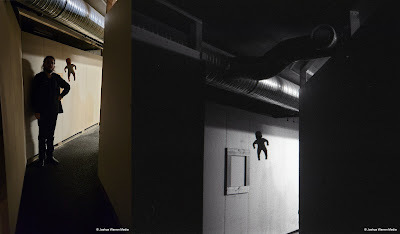 Left: Probably on of the oddest BTS photos that has been taken of me. Right: The original B&W photo before it was photoshopped beyond recognition.
Left: Probably on of the oddest BTS photos that has been taken of me. Right: The original B&W photo before it was photoshopped beyond recognition.ODDS AND ENDS
Finally, just to be thorough, and in casesome of you were wondering, here’s a brief explanation of the remaining photos that, in my opinion, didn’t have enough of a story behind them to warrant giving them their own section.
The house and the stairs representing the home of the kidnapped child were two separate locations, with the latter belonging to an artist friend of mine who not only lived in a house from the70s but who collects all things odd and retro, such as the radio and the old Dole cardboard box that you can see at the bottom and top of the stairs. The house seen from the outside belongs to some old friends of my mother.
The stone circle is an actual pre-historic stone circle in Egersund which I have already written about in detail in my article about the Locations that Inspired The Starseed.
The two photos of the Aker H3 drill rig, and of the petroleum workers within, are historical stock photos generously provided by Norsk Oljemuseum (The Norwegian Petroleum Museum).
And finally, though I did both the photo and the video editing myself, the rest of the post-production phase was largely done through people I know via The London Film Academy (the sound editing was done in Norway by Bibow Audio, who worked on both of my 2022 short films). The music was composed by Isabel Woodings, who was recommended to my by the co-producer and 2nd unit director of my short film Paradox, Oscar Hewitt, who on this project was also responsible for the voice-over recording.
The narration was done by voice actor David Mander, whom I discovered through an online casting process. The recording took place at the London Film Academy with Hewitt organising what can best be described as "long-distance-directing," meaning I directed the whole affair via Google Meet while Hewitt and Mander were together in the studio in London. Contrary to much of the analogue process used in the making of this trailer, this final step was a very modern solution that worked surprisingly well.
February 23, 2024
The Locations that Inspired The Starseed (Part 2)
This is the second part of my breakdown of the real-life locations that inspired Professor Korrigan's three-day adventure through the Norwegian west-coast in my novel; The Starseed.
If you haven't already read Part 1 you can do so here.
Mild spoiler warnings for the plot of The Starseed.Just in case you haven’t read the novel yet, I have made sure to avoid any major character or plot-driven spoilers in this article, however, the locations themselves, especially the later ones featured here, can be considered plot spoilers in and of themselves.
The small fishing village of Lunvik that I introduce about halfway through the story is the only settlement in the novel that is entirely fictitious, though naturally inspired by real locations. The village is in many ways an amalgamation of several villages that I have visited, but the one place that I drew the most inspiration from—though I only realised this after the fact—was the small port town called Skudeneshavn.
The name Skudeneshavn is quite fascinating, and is a combination of three words. The first part comes from the Old Norse; Skúta, which literally means “protruding rocks” and refers to the rocky skerries that line the shore around the southern end of the island. Nes and havn, two words that are still in use in modern Norwegian, translates to “headland” and “port.” Due to the archaic nature of the first third of the name, with skude being very similar to modern word skute, I was always under the misconception that it referred to the “ships” that would enter the port at the headland. Ask most Norwegians what the name means and they’ll likely give you the same answer.
As the actual name suggests, it is a very old port town. It lies at the very tip of the large island county of Karmøy, where, a bit further north, you’ll find the historically important site of Avaldnes (more on this later).
 Skudeneshavn in 2016.The one thing that separates Skudeneshavn from the fictional village of Lunvik, however, is its complete lack of mountains. Although mountains were never far away during my upbringing—in fact the backdrop of the nearest grocery store was a mountain range on the opposite side of the Bokna fjord—the landscape where none-the-less relatively flat, consisting mostly of rolling hills and the occasional bump in the landscape that neither qualifies as hill nor mountain. I actually grew up at the foot of one of these bumps, or nut (pronounced “noot”) as they’re called in Norway, a word with no direct English translation. So, I was thankfully spared having to cycle down mountain roads like the two unfortunate boys at the start of the chapter I somewhat dramatically titled Draugen. My great-great-great grandfather on the other hand, did grow up in a place not too dissimilar.
Skudeneshavn in 2016.The one thing that separates Skudeneshavn from the fictional village of Lunvik, however, is its complete lack of mountains. Although mountains were never far away during my upbringing—in fact the backdrop of the nearest grocery store was a mountain range on the opposite side of the Bokna fjord—the landscape where none-the-less relatively flat, consisting mostly of rolling hills and the occasional bump in the landscape that neither qualifies as hill nor mountain. I actually grew up at the foot of one of these bumps, or nut (pronounced “noot”) as they’re called in Norway, a word with no direct English translation. So, I was thankfully spared having to cycle down mountain roads like the two unfortunate boys at the start of the chapter I somewhat dramatically titled Draugen. My great-great-great grandfather on the other hand, did grow up in a place not too dissimilar.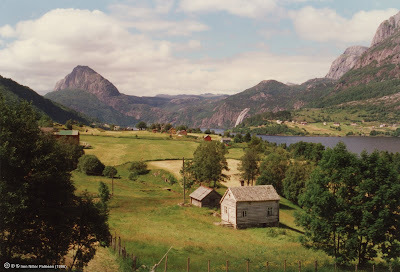 Farmland near the village of Dale photographed by my mother in July 1996.
Farmland near the village of Dale photographed by my mother in July 1996.In the village of Dale (the name literally translates to “valley”) you are quite literally flanked by mountains on all sides, with your only means of exit or entry being a slim, winding road through the mountains, or by water through one of the many veins of the Sunnfjord. Unlike the comparatively large town of Skudeneshavn, this is the type of village that has a single grocery store and a “shopping centre” consisting of four stores, and that’s including the aforementioned grocery store. And in this way, I suppose Dale is actually a much closer approximation to the fictional Lunvik, if only in size rather than its overall aesthetic. Since Dale lies far within the Sunnfjord, unlike Lunvik which lies by the coast at the mouth of a fjord, it is not a port town, but rather a community that once made its living from factories, exporting mainly shoes and barrels.
As I alluded to before, part of my family comes from this village; specifically the Nitter branch on my grandmother’s side. The Nitters were quite well-off and there were quite a few fascinating characters living in Dale in the 19th century, though the one that I have always heard a lot about—thanks in large part to him having kept a very detailed diary—was Adolph Nitter, my great-great-great grandfather. Well educated and well read, Adolph’s writings were both eloquent and insightful, providing a fascinating glimpse into life in Europe two centuries ago. Since he came from an affluent family, and since he was groomed to take over his uncle’s trade, he was able to travel abroad in a way that few others were able to in his days.
His father (i.e. my great-great-great-great grandfather) was a lensmann, which, as I also described in the novel itself, means that he was the police chief. They even had a little cell for prisoners in the house itself. But it was Adolph’s son; Einar, who eventually left Dale behind, moved to Stavanger, and the rest is history.
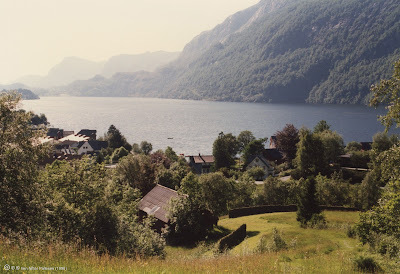 The village of Dale seen from the old Nitter house atop the hill. Photo taken in July 1996.
The village of Dale seen from the old Nitter house atop the hill. Photo taken in July 1996.
The reading room of the University of Bergen Library that I describe at the midpoint of the novel is the only location that isn’t based on any place that I have actually been to, be it directly or indirectly. Granted, I have been to many libraries throughout my life, as well as a few archives, so I suppose you could categorise this location as being based on an educated guess rather than anything related to personal experience. Of course, the library itself does exist, but although I have visited the city of Bergen several times I’ve never had any reason to visit it. I originally had Korrigan visit the Bergen Public Library, a very striking-looking neo-Romanesque building that I have passed by on many occasions due to it being located right next to the railway station, but decided that the university library made much more sense for an academic. The public library does, despite its somewhat mundane name, house many old books in their archives, though largely related to local history. Not quite fitting for the esoteric Icelandic compendium that Korrigan reads through in the novel.
Of course, Korrigan visits more than just the library in Bergen, though I can thankfully say that I have never needed to visit the police station.
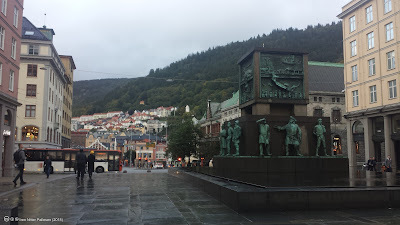 The main square in downtown Bergen on a rainy August day in 2018.
The main square in downtown Bergen on a rainy August day in 2018.The hotel that I usually stay in when visiting the city was not converted to a hotel until the late 90s, and was as such of no use to me while writing about Korrigan’s brief overnight stay in 1975.
After researching the history of well-established hotels in Bergen—a task that proved far more complex than I had imagined it would be—I finally concluded that the Hordaheimen Hotel would suit my purposes for the story. Although I have never been to this hotel, and I could easily have just made up a name for it seeing as not much happens at this location other than Korrigan finally getting a relatively good night's sleep, it did prove to be something of a fascinating rabbit hole. Not only did the hotel once house a famous (and quite huge) painting of St. Olav Haraldsson (King of Norway from 1015 to 1028) by Nils Bergslien (1853-1928) in the dining room, but it has also a fascinating connection to one of the most well-known unsolved crimes in Norwegian history; the so-called “Isdal Woman.” In November 1970 an unidentified woman was found dead in Isdalen (“The Ice Valley”) near the city. The last time she was seen alive she had checked out of Room 407 at the Hordaheimen hotel where she had stayed under one of what later turned out to be several false identities. It is generally believed that she was a spy, though I’m not going to delve into all the details of this case here. But if you're fascinated by real-life cold war mysteries, then this one is definitely worth your time.
Lastly, I’d like to point out that contrary to my somewhat gloomy description of the city in the novel, I do actually think Bergen is a really nice place. So, in order to make up for it, here’s a nice sunny photo to give you a more cheerful impression.
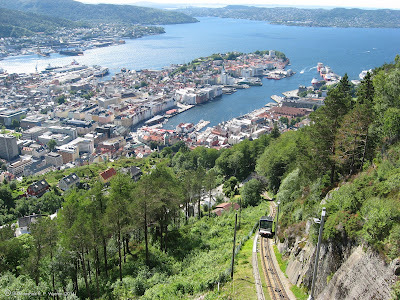 Photo taken in 2014 from the viewing platform atop Fløyfjellet which can be easily accessed via the Fløybanen funicular railway with the lower terminus down in the city.
Photo taken in 2014 from the viewing platform atop Fløyfjellet which can be easily accessed via the Fløybanen funicular railway with the lower terminus down in the city.
STOPLESTEINAN
You might have thought that the stone circle Korrigan finds hidden within the small patch of trees at the terminus of the Heimrinn fjord had to be a purely fictitious place, but when Hagen casually stated that there must be thousands of stone circles all around the country it was no exaggeration. Norway really is littered with standing stones to the point where most of them remain largely ignored by all but the most committed history buffs. It is not uncommon to still find lone marker stones in the middle of some field with no sign or trail to indicate that there is anything of historical value. Of course, they are protected by the state, but unless there is something particularly unusual about them, or if there’s more than one, then there is rarely any effort made to make them easily accessible—something which I have experienced on more than one occasion.
One unusual collection of standing stones that do have both signs and a path to follow, though only barely, are Stoplesteinan in Egersund.
Egersund is a port town a little less than an hour by train south of Stavanger (and about 30 minutes from where I live now). It is a city I am quite familiar with for multiple reasons, the first being that my late grandfather had a summer house on an island close to the city, and the second being that it is something of a local tradition to visit the city during the Christmas season as Egersund is famous for “Julebyen,” an elaborate Christmas market that have been held there every year for as long as I can remember. However, I have never ventured past the city centre, and in order to access Stoplesteinan you have to walk through the city, into the suburbs, and up a very steep hill that at first seems to lead you right up into someone’s driveway—which you do—until you spot a tiny bridge—a plank of wood really—over a small stream that leads to a downtrodden path. As is quite typical with Norwegian forest trails, apart from a few rudimentary means to help you cross the occasional stream and fence, there is not much to go by other than a simple trail. And when I say trail, I mean a trail in the true sense. I’m not talking about a gravel road, I mean a thin, irregular line of downtrodden grass that indicates that at least some other human beings have walked there before. Eventually you make your way up to the top of a plateau nestled in between two “bumps” in the landscape and there you will find a circle of 16 stones. The tallest ones are roughly waist-high compared to your average adult male. There are no visible carvings of any kinds on these stones, and their original purpose can only be guessed at.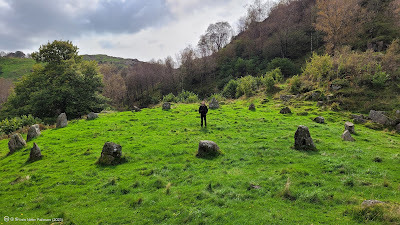 Standing at the centre of Stoplesteinan in 2023.
Standing at the centre of Stoplesteinan in 2023.It’s a peculiar little site really. When standing at the centre of the stone circle, in all directions but west (where the suburbs are quite visible in the gap between the two “bumps”) you can hardly see any signs of civilisation apart from the occasional power lines on the far horizon. It is almost like you have stepped back in time to the ancient past and you begin to wonder what the purpose of this place originally was. Even though Google Maps reveal that the stones are nestled in between the Egersund suburbs and a cluster of farms, it is still very much on the edge of the modern world. To the east lies nothing but 250 km (150 miles) of mountainous wilderness that stretches all the way to the east coast. Even in the 21st century, much like in the Viking age, people generally live along the coast and the centre of the bulbous shaped bottom half of the country is—apart from the occasional rarely traversed road—the same today as it would have been a thousand years ago, or ten thousand years for that matter.
At this point in the text, I would normally have included a translation of the name of this place, but I must confess that I haven’t the faintest idea what a stople is supposed to be, and all my attempts at Googling it haven't turned up any satisfactory answers either. What I can say, however, and without having to look up any Norse translations, is that “steinan” simply means “stones,” so there’s that.
And finally, I’d also like to point out that I visited Stoplesteinan quite far into the process of writing The Starseed, so I can’t truly claim this to be the primary source of inspiration of the mysterious magnetic stone circle described in the novel, rather I visited it for the purpose of photographing it for my book trailer. If you haven’t already seen it, you can do so here.THE LNG TANKER SHIP AT AVALDSNES
You never know when inspiration will hit you, and hit me it did during a visit to Avaldsnes on the island of Karmøy some two-hours by bus and ferry north of Stavanger. Avaldsnes is in many ways the birthplace of Professor Korrigan, as it was there I got the inspiration for both The Starseed and the upcoming follow-up novel; The Highland Incident. I will detail the origins of the latter story some other time, but it was during a visit in 2021 that I spotted something odd that once more spurred on my imagination.
For those who are interested in history there are three main attractions to visit at Karmøy; St. Olav's Church at Avaldsnes, the Nordvegen History Centre right “next door” to the church, and The Viking Farm on Bukkøya—a recreated Viking age village not too dissimilar to The Iron Age Farm in Stavanger. After having paid a visit to the church and the museum during the summer of 2021 I stopped in the cafeteria for a lunch break and looked out a window over the grassy hills that lead to Bukkøya, where the Viking village lies hidden within a forest. My eyes swept the rocky hills and I spotted the occasional sheep munching on the grass before coming to a stop at the channel of ocean water that separates Karmøy from the city of Haugesund on the mainland, and there I saw a large anchored tanker ship. As someone who grew up in a port town with strong ties to the oil industry, I thought little of it other than noting the somewhat unusual look of the bulbous gas tanks and continued with my lunch.
 The LNG tanker ‘Gulf Energy’ was, according to a marine traffic website I found, built in 1978 and is currently (as of 2024) not in service. Photo taken in 2021.
The LNG tanker ‘Gulf Energy’ was, according to a marine traffic website I found, built in 1978 and is currently (as of 2024) not in service. Photo taken in 2021.Once I finished my lunch I left the museum and started the short trek over to the Viking village. I casually noted that the tanker was still there, but my mind was more focused on all things Vikings since this was less than a month after the shoot of my fantasy short film in Stavanger. A little over an hour later, once I had seen everything the Viking village had to offer, I crossed this open patch of land once more and again the tanker was just sitting there on the water. Now it drew my full attention, and I found myself attaching my zoom lens to my camera and I began taking pictures of it. Although I could see the city in the distance, the tanker was mostly framed against forested hills in addition to being partially covered by the northern tip of Bukkøya, creating a strange contrast of nature and modern engineering. In my mind I began erasing the city in the distance, I removed the nearby houses, the bridge, and I imagined it all alone, surrounded only by nature. There were no people onboard that I could see, even with my zoom lens. Why was it there? Who had brought it here? What was hiding within its steel hull? For whatever reason I imagined that there was some kind of alien hidden within, and thus the first seed of an idea for a novel had been planted in my head.
Mysterious tanker ships aside, Avaldsnes is a very fascinating place and one of the most historically rich places in all of Norway. It served as the capital of Norway during the Viking age and was the seat of power for the aforementioned king Harald Fairhair who united all of Norway at the battle of Hafrsfjord just downhill from the Iron Age Farm at Ullandhaug. And as I alluded to before, my next Korrigan novel; The Highland Incident, has its roots in an apocalyptic legend connected to the church that rests atop the hill looking down at the strange ghost ship resting in the Karmsund strait.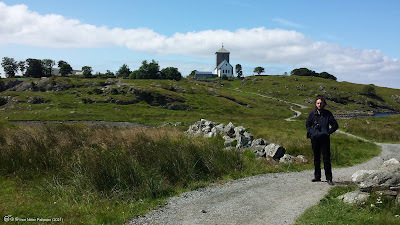 The church at Avaldsnes in 2021. The small building just to the left of the church was a temporary structure built around an archaeological excavation. The museum can be seen between the trees on the far left.
The church at Avaldsnes in 2021. The small building just to the left of the church was a temporary structure built around an archaeological excavation. The museum can be seen between the trees on the far left.A special thanks to my mother for letting me scour through her photo albums for a lot of these pictures, and for helping me find some that I didn’t even know existed.
February 18, 2024
The Locations that Inspired The Starseed (Part 1)
If you have already read my sci-fi mystery novel; The Starseed, you might have wondered which of the many locations described in the book are real and which are not. You might have Googled a few, or you might even have already been familiar with some of them, but if I have done my work well then there will also have been a certain ambiguity about at least some of the places visited by Professor Korrigan during his three-day journey through the west coast of Norway.
It is no coincidence that I chose the west coast as the setting for my first novel set in the real world, as I myself grew up in this part of the country—granted a few decades after the book’s setting of 1975. By the time I came into the world in the early 90s the “oil adventure” was already starting to wind down, though it was still very much an unavoidable part of the culture. And my hometown of Stavanger was, and still is in some ways, seen as the “oil capital” of Norway. With these influences I suppose it was only a matter of time before it made its way into my writings.
So, as you can imagine, every single location described in the novel, whether real or made up, will have some connection to actual places that have some meaning to me. Listed here—in order of appearance in the novel—is every town, village and vehicle with a short breakdown of their real-life counterparts.
Mild spoiler warnings for the plot of The Starseed.Just in case you haven’t read the novel yet, I have made sure to avoid any major character or plot-driven spoilers in this article, however, the locations themselves, especially the later ones in part two, can be considered plot spoilers in and of themselves.
In my hometown of Stavanger, just a few kilometres uphill from the inlet where Harald Fairhair united the tribes of Norway into a single nation after the battle of Hafrsfjord in 872 AD, a trio of carefully reconstructed iron age longhouses lie in the shadows of three brutalist apartment blocks from the mid-1970s.
Having been history buff and an armchair archaeologist my entire life it goes without saying that I have visited the Iron Age Farm at Ullandhaug many times over the years, and the odd contrasts of this location has never ceased to amuse me. The illusion of having travelled back to the age of the Vikings would have been perfect had it not been for the three apartment buildings that always seem to intrude upon the scene whenever you try to take a nice picture of the place. And if you try to take a picture southward, with the mountains of the Bokna Fjord clearly visible on the horizon, you will also get a nice panoramic view of the University in Stavanger, not to mention the peculiar-looking old telecommunications tower that stands atop a forested hill nearby.
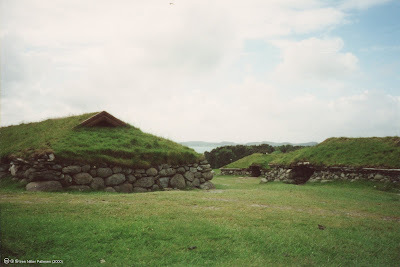 One of the few “clean” views of The Iron Age Farm at Ullandhaug back in 2000 before the construction of the visitor centre.
One of the few “clean” views of The Iron Age Farm at Ullandhaug back in 2000 before the construction of the visitor centre.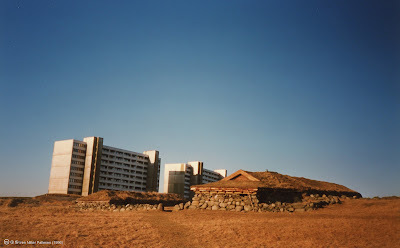 Stone and concrete. These brutalist apartment buildings were raised in mid-1975, the same year as the Iron Age Farm reconstruction was completed. Photo taken in Feb. 1996.
Stone and concrete. These brutalist apartment buildings were raised in mid-1975, the same year as the Iron Age Farm reconstruction was completed. Photo taken in Feb. 1996.
Ullandhaug, much like the plot of The Starseed, is a fascinating tapestry of the old and the new placed side-by-side. It therefore seemed appropriate to start my story in a location inspired by Ullandhaug. Likewise, what better way to introduce an archaeologist than having him partake in an archaeological dig.
Although I’m a sucker for pulpy adventures about daring explorers discovering ancient temples in the jungles of India or in the Egyptian desert, Korrigan is not Indiana Jones, so for this story I wanted to depict a realistic archaeological excavation that allowed me to incorporate the changeling myth that is central to the novel. The slow and laborious process of an excavation is admittedly not the most exciting thing to read about, but I knew it would serve as a good introduction to my characters and themes, and since ancient Norway was once littered with homesteads like the one at Ullandhaug, I figured a near-identical one could be buried under the fields of some farm in the nearby county of Suldal. As a matter of fact, while in the late stages of writing the novel, I found out that archaeologists had recently performed a series of lidar sweeps over Ritland in Suldal proving the presence of multiple prehistoric settlements. I could make some joke about having a sixth sense for archaeology, but you could dig in almost any field near the south-west coast and find signs of ancient habitation. Case in point, one of the most important archaeological digs in Stavanger (the excavation of the so-called “Gausel Queen” from 1997-1999) was a mere fifteen-minute walk away from where I grew up. I remember my mother taking me to watch the archaeologists work when I was seven years old. Clearly it must have had a strong effect on me.
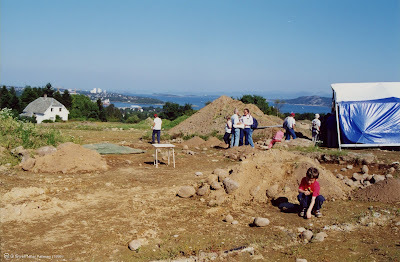 The excavation of Dronningåsen ("The Queen's Hill") in September 1999. The kid in the red T-shirt is me.
The excavation of Dronningåsen ("The Queen's Hill") in September 1999. The kid in the red T-shirt is me.A few years later as part of a field trip during my short tenure as a Boy Scout I spent a whole day, and night, at the iron age farm at Ullandhaug. This was many years before the construction of the nice visitor centre that now stands at the foot of the hill, so we slept in sleeping bags placed atop sheepskin covered wooden benches, and the closest thing we had to a bathroom was a small, smelly outhouse with a door that didn’t close.
Almost two decades later I returned to the Iron Age Farm, not as a history enthusiast, but as a filmmaker, and used one of the longhouses as a shooting location for my 2022 Fantasy short film; The Wild Huntsman. If you’re curious, you can watch the whole 5 min. short here.
 Shooting a scene with actor Vegard Heggelund at the Iron Age Farm during the summer of 2021. Photo by Kornelius Kiil Enoksen.
Shooting a scene with actor Vegard Heggelund at the Iron Age Farm during the summer of 2021. Photo by Kornelius Kiil Enoksen.
The inclusion of the Tau ferry docks, though very brief, actually carries a bit of significance for a local like myself, doubly so as someone who quite enjoys the whole atmosphere of ferry rides, something which is sadly becoming less common nowadays. Up until the completion of the Ryfast subsea tunnel system in 2019, the only two ways to get to Tau (and Suldal) from the Stavanger peninsula was either to drive around the whole arm of the Bokna fjord, or to take the Tau-Stavanger ferry. Since Tau is the largest settlement near Pulpit Rock (if you’re not already familiar with it, you might have seen Tom Cruise climb it during the climax of Mission Impossible: Fallout) it was the most natural place for tourists and locals alike to travel through, that is, until the tunnel was built.
The tunnel is naturally faster and more convenient, but in my opinion, a poor substitute for the charm of taking the ferry across the fjord on a sunny summer day on your way to hike up to one of Norway’s most iconic locations. Although I grew up in the suburbs of Stavanger on the opposite side of the fjord, I somehow never got around to visiting Pulpit Rock until I was in my early twenties, when I did the hike with a good American friend of mine that was visiting in 2014. Judging from his holiday photos from his visit I’d venture a guess that he would agree with my assessment that the ferry was an integral part of the charm of the whole trip. A few years later he visited Norway again, this time bringing along his wife (he’d gotten married since his last visit), and although we chose another, even more scenic route this time, we still had to take a ferry. The third time I went to pulpit rock, this time with my brother (his first time) and an American relative (it was a first for him too) we naturally took the Tau-Stavanger ferry. This was in 2018, one year before the completion of the tunnel, and therefore my last trip with the ferry.
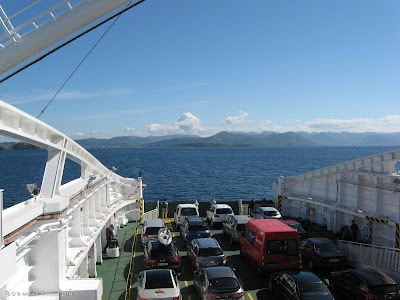 I couldn't find any photos of the Tau ferry docks, so here's the ferry on its way there in 2014.
I couldn't find any photos of the Tau ferry docks, so here's the ferry on its way there in 2014.STAVANGER
When I first started working on The Starseed I decided that I wouldn’t dwell too much on the city of Stavanger despite it being my hometown and chose instead to make it part of Professor Korrigan’s journey from the excavation to the drill rig. After all, if you wanted to fly out to any form of petroleum industry-related rig in 1975 it would have to be through Stavanger. However, I couldn’t ignore the city of my upbringing entirely, so what started as a few simple sentences evolved into a brief tour of downtown Stavanger, appropriately seen through a historical lens.
The route that Korrigan takes in the book, starting at Østervåg, then following through Vågen and finally into the town square, is for all intents and purposes one of necessity and historical accuracy, and yet it very much is a perfect summary of the history of the city. I did in no way exaggerate when I described it as a thousand years of history crammed into less than a minute of driving.
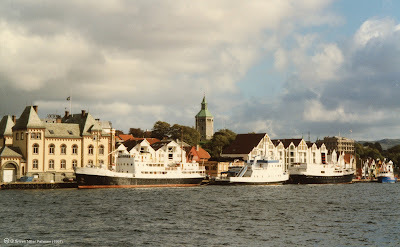 Vågen bay, Stavanger, in 1997, though it appears much the same today and would not have changed much since the novel’s setting of 1975 either.
Vågen bay, Stavanger, in 1997, though it appears much the same today and would not have changed much since the novel’s setting of 1975 either.
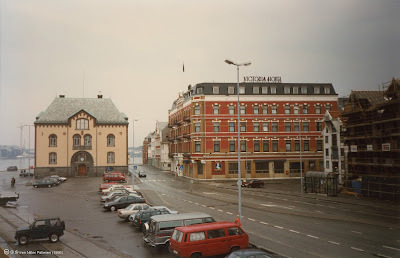 Toldboden (left) and Victoria Hotel (right) on a grey April morning in 1996, not too different from how Korrigan would have seen them in March of 1975.
Toldboden (left) and Victoria Hotel (right) on a grey April morning in 1996, not too different from how Korrigan would have seen them in March of 1975.
Even today, if you stand at the end of the bay at Vågen and you look out towards the fjord you are likely to see some pretty large signs of industry as you’ll be facing the Rosenberg shipyard. And although you are not likely to see any oil rigs under construction anymore, you are still likely to spot some kind of tanker or cargo ship not unlike the ones observed by Korrigan on his ferry ride into the city. Turn around and look in any direction and you’ll see plenty of signs of Stavanger’s maritime history, from the traditional porthouses now turned into bars and nightclubs to your left, and to your right, towering above most other buildings you’ll find the modernist Ankerbygget (literal translation: “The Anchor Building”). Look closely and you’ll find anchors incorporated not only into the wrought iron balconies but also in the granite façade itself. Stavanger is not only a thousand years of visible history in one place, but a living tribute to all things maritime.
But on the opposite side of the town square, slightly to the left of the Stavanger Cathedral School, you’ll see a grey granite cathedral that has looked very much the same as it has done for the past 900 years; Domkirken.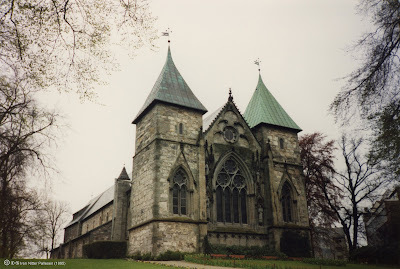 The Stavanger Cathedral in 1995 before the recent renovation work done in preparation for its 900th anniversary in 2025. This shows the more extravagant rear view as opposed to the simpler, more mediaeval-looking front end that Korrigan would have seen.
The Stavanger Cathedral in 1995 before the recent renovation work done in preparation for its 900th anniversary in 2025. This shows the more extravagant rear view as opposed to the simpler, more mediaeval-looking front end that Korrigan would have seen.Stavanger Cathedral—colloquially known as Domkirken—is the oldest cathedral that’s been in continuous use in Norway and was finished around 1150, though the city counts the year 1125 as its official foundation. Some experts maintain that part of the structure could date back as far as 1090, with others claiming that an old wooden church could have stood on the site for several centuries prior. The elaborate gothic façade on the east end (pictured above) was constructed in the late 13th century after the city had been ravaged by a fire in 1272. The western façade with the main entrance, which is the side that Korrigan would have glimpsed during his brief drive through downtown Stavanger, has a much more modest and mediaeval look to it.
Although the nave has always been open to the public (with certain exceptions), I have been fortunate to get to visit some of the less commonly seen parts of the cathedral over the years, such as the crypt and even the bell tower. In preparations for the city and the cathedral’s joint 900th anniversary in 2025, the church has been undergoing extensive renovations and has been entirely closed off since 2020. Unfortunate news for tourists, but it has been a golden opportunity for local archeologists who have used the restoration process as an excuse to excavate in places that have previously been completely out of limits.FORUS AIRPORT
The location of the partially abandoned runway described in the third chapter is pretty much “down the road” from where I grew up, though by my time there was little to suggest it had once been an airstrip. As a kid me and my friends would often cross this location as a shortcut to the mall. We’d go down the hill, through the tunnel under the E39, and then step through a hole in a fence that took us to a large empty square of asphalt that I was always told used to be a landing platform for helicopters. At the time I didn’t think much of it, my mind was usually focused on the contents of the toy store or the pet shop (I had a friend who collected stick insects) hidden behind the row of office buildings and workshops on the other side of the empty lot.
As I describe in the novel, this simple airstrip was built by the Deutsche Luftwaffe in 1941 at the start of the German occupation of Norway. After the war it was supposed to be used by the Norwegian military, but little ever came out of it, presumably due to the much larger airport in Sola which is a short drive away. During the late 60s the airstrip was finally put to use by Helikopter Service as a means to ferry workers out to numerous oil rigs that were popping up all over the North Sea. The airstrip was used as a helicopter base until 1989 when a new and improved helicopter terminal was opened at Sola airport. Since the helicopters had no need of the full length of the three taxiways, it was not uncommon for the locals to use the empty stretches of tarmac to help their teenage children practise for their driver’s licence. In fact, my mother learned to drive there in the late 70s.
Researching this familiar, but once very different locale for the book, was at once fascinating and somewhat difficult as there are very few photos of the place during the 70s. Small patches of the old taxiway can still be found here and there, having been converted into parking lots or integrated with new roads, and from what I’ve read online one of the maintenance hangars still exists.
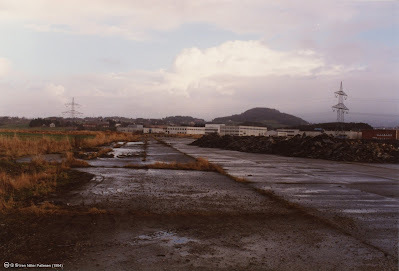 What was left of the airstrip in 1994, photographed by my mother. Although this predates it by a couple of years, I spent most of my childhood living at the foot of the hill you can see in the far background.
What was left of the airstrip in 1994, photographed by my mother. Although this predates it by a couple of years, I spent most of my childhood living at the foot of the hill you can see in the far background.SOLA AVIATION MUSEUM
Although a very minor influence on the actual story, and despite Sola airport only being mentioned in passing in the book, I would still feel remiss if I did not mention the Aviation Museum at Sola.
This is very much the kind of old-fashioned, no-nonsense museum that I sorely miss these days and that seemed to be the norm when I was a child. It is the very definition of utilitarian and is completely devoid of the pretentious art-gallery vibe that is so common in modern museums. What you see is what you get, and the locale itself is as much a piece of history as the exhibitions within.
 The museum was founded in 1984 and is run by local volunteers. Photo taken July 2023.
The museum was founded in 1984 and is run by local volunteers. Photo taken July 2023.The museum itself is an old WWII aircraft hangar stuffed with all kinds of aircraft, ranging from something as small and simple as a former civilian owned Bell 47 single-rotor, single-engine light helicopter, to a duo of American jet fighters from the 50s such as the Republic F-84G Thunderjet and the RF-84F Thunderflash. They have various German Luftwaffe aircraft such as a Messerschmitt Bf 109, as well as the only remaining airframe of an Arado 196 which was stationed on the Kriegsmarine cruiser ship the Blücher, which was sunk in the Oslofjord in April 1940. As if such an assortment of fighter jets, both partial and complete, were not impressive enough, standing dead-smack in the centre of the hangar is a full-on Douglas DC-6 airliner with a capacity of up to 70 passengers. And as if one full airliner wasn’t enough, standing beside it is a slightly smaller, but still massive, Convair CV-440 Metropolitan once used by SAS and Norfly. But the most impressive plane in the collection by far (or at least in my opinion), has to be their beautifully restored, black-painted Consolidated PBY-5A Catalina amphibious aircraft from the 1930s. Although not the largest plane in the hangar, and by no means the most spacious one within, there is just something raw and menacing about the massive silhouette of this beast of a flying boat, aided in no small part by its pair of massive three-bladed propellers attached to the 32 metre (104 ft) wings raised above the fuselage like some massive predatory bird about to take flight. I am also a sucker for all things 1930s and 40s, and the domed gun turrets give it that vintage charm that in my opinion has never been surpassed.
However, at the end of the day, I came for a single purpose—one perhaps a tad mundane compared to all that I’ve described so far, and that was to get a good look at the museum’s Bell UH-1 Iroquois (or “Huey”) helicopter, as I know a few of them would be an important part of the eventual discovery of the stolen LNG tanker ship in the novel. Compared to the MD 500 (“flying egg”) used by Marshall, the UH-1 does play a fairly small part in the plot, but since the museum didn’t have an MD 500, I had to consult online sources in that case. I did likewise for the UH-1, of course, but when there was one sitting in an aircraft hangar less than an hour away from where I live, I figured it was as good an excuse as any to go and visit a museum I had not been to since I was a kid. Besides, the trip did prove useful to my research after all, and the information accompanying the helicopter did clarify a question I had about where the Norwegian Air Force's Hueys would have been stationed in 1975. Getting to inspect one in person also gave me a good indication of just how many people could realistically be crammed into a single helicopter, making me realise that the passenger capacities I had read online were quite ambitious.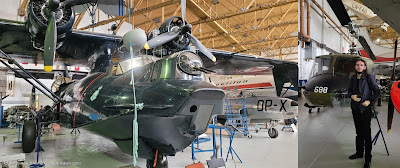 Left: A Consolidated PBY-5A Catalina from 1932. Right: Bell UH-1 ("Huey") helicopter formerly owned by the Royal Norwegian Air Force. Photos taken July 2023.
Left: A Consolidated PBY-5A Catalina from 1932. Right: Bell UH-1 ("Huey") helicopter formerly owned by the Royal Norwegian Air Force. Photos taken July 2023.
THE NORWEGIAN PETROLEUM MUSEUM
Although I grew up surrounded by people working in the petroleum industry—heck the headquarters for Statoil was right down the road—I’ve never actually been to a rig of any kind. It’s not exactly like you can just pop down to the nearest oil rig and ask if you can have a look around. I have, however, been to the next best thing; The Norwegian Petroleum Museum.
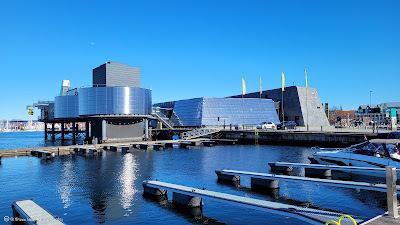 Photo taken in 2023 showing the back-view of the museum with the mini ‘oil rig’ protruding from the main building on the left.
Photo taken in 2023 showing the back-view of the museum with the mini ‘oil rig’ protruding from the main building on the left.Opened in 1999, the petroleum museum, much like the Iron Age Farm, is one of those places I’ve continually visited since I was a kid, either through school or on my own accord, though admittedly, I never all that much attention to the historical or technical nuances of the exhibits until I got the idea to set my first Korrigan novel in Norway during the oil rush in the 1970s.
The one part of the museum that has always stood out to me, is the large back-section that emulates an oil rig. At first you step into a fake plane, complete with sound effects and TV screens in the windows, and then you step onto a walkway that takes you out of the museum and onto the “rig,” complete with crane, emergency raft, a genuine control module filled with retro-looking buttons and levers, a more modern control chair that looks like something out of a sci-fi movie, and even an escape chute for the kids to try out. Although the “effects” used to immerse you in this experience were, and still are, somewhat crude, it was still very much an experience that left a big impression on me as a child.
 A 7-year-old me on the mini-rig on opening day, May 20th, 1999. The Rosenberg shipyard can be seen in the background. I still have the ticket stub from that day. The text reads: The Norwegian Petroleum adventure began when this drill bit struck oil in 1969. The rest is history.”
A 7-year-old me on the mini-rig on opening day, May 20th, 1999. The Rosenberg shipyard can be seen in the background. I still have the ticket stub from that day. The text reads: The Norwegian Petroleum adventure began when this drill bit struck oil in 1969. The rest is history.”CONTINUED IN PART 2.
February 14, 2024
THE STARSEED: A Professor Korrigan Mystery
One night in February of 1975, a group of young men and women broke into a random house on the west-coast of Norway and abducted an infant child. A note with a pagan symbol used in ancient magic rituals was left in the crib. It was the first of several clues to the terrible secret of THE STARSEED.
Genre
: Paranormal Mystery.
Setting
: Norway, 1975.
Date of publication
: December 17, 2023
The Starseed is the first book in a planned series following the paranormal adventures of the English archaeologist, Professor Mortimer Korrigan.
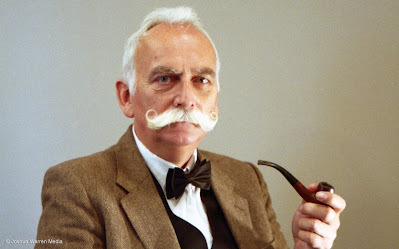 Professor Mortimer Korrigan is an accomplished, if not slightly infamous, archaeologist. Though a prolific researcher and excavator, his successes are often overshadowed by his failures—failures that often garner much publicity due to the eccentric claims that often preceded them. Little does the general public know just how right he really is. (Photo model: Arne Vagle.)
Professor Mortimer Korrigan is an accomplished, if not slightly infamous, archaeologist. Though a prolific researcher and excavator, his successes are often overshadowed by his failures—failures that often garner much publicity due to the eccentric claims that often preceded them. Little does the general public know just how right he really is. (Photo model: Arne Vagle.)
HOW THIS NOVEL CAME TO BE
As a fan of both Mysteries and Horror it was only a matter of time before I dipped my toes into both genres. And while I enjoy a good straight forward murder mystery, it is not a genre I was interested in writing myself, that is, without adding some “fantasy gimmick” to make it more me (note that I use fantasy in the broader sense of the word here, as in fantastical, not in the orcs and dragons sense). My solution then was to make a paranormal mystery in the tradition of the old “occult detective” genre, albeit with my own modern-ish spin to it.
While I am by no means a believer in the paranormal (though I do try to keep an open mind), I have always been fascinated by TV shows like Kolchak: The Night Stalker and The X-Files, the latter of which always managed to bring a strong sense of realism to stories that dealt with extraordinary threats like aliens and ghosts and other things that go bump in the night. What could have easily turned into a simple monster-hunter series managed to tell very human stories that more often than not dealt with very real issues. I’ve always liked that approach to fiction, where the extraordinary represents some facet of humanity, or if not, it does at the very least provide a narrative opportunity for the characters to respond to it in ways that say a lot about who they are, or even who we all are as a species.
It is no wonder then that I immediately become a huge admirer of Nigel Kneale, the writer of such classic BBC series as Quatermass and the Pit, whom I first discovered while putting the finishing touches on my first novel; Dawn of the Karabu. Stripped of any gimmicks, Kneale’s paranormal stories were really about the world around him, often tackling serious issues like class differences, authoritarianism, and racial tensions. And while I personally don’t hold any disdain for escapist fiction the way that Kneale often did, I do feel that so-called ‘genre fiction’ like Science-fiction and Horror are at their best when dealing with real issues in this manner and it is a philosophy that I very much aspire to emulate in my own work.
 André Morell as rocket scientist Bernard Quatermass in the 1958 miniseries 'Quatermass and the Pit.'
André Morell as rocket scientist Bernard Quatermass in the 1958 miniseries 'Quatermass and the Pit.' Copyright © BBC.
The resulting idea that came from all of this, however, was not The Starseed. I initially started working on a novel called The Highland Incident, a kind of ‘old dark house’ style story set primarily in a Scottish abbey, though now that I had begun developing what I intended to be a recurring character, it was hard not to start looking ahead and start planning what his other adventures would be. This wasn’t just me getting caught up in the world-building, but also a bit of a necessity as the middle-aged Professor Korrigan would from the beginning be established as someone who had already gone through several adventures. It was during this process that I started toying with the idea of a story set in my own home region in the south-west coast of Norway, and keeping in mind that I wanted my stories to have some form of historical and cultural relevance it only made sense to focus on the oil rush that started in the late 1960s and was still very much alive when I was growing up in the city of Stavanger (one of several real locations visited in the book). Of course, this immediately meant that the story would have to take place after the events of The Highland Incident, which takes place in 1967, as the “Norwegian Oil Adventure” didn’t truly begin before 1969. It seemed like the beginning of a good idea, and I quickly decided it would make for a good short story that I could hopefully get published somewhere as a little teaser for my upcoming Korrigan novel. Needless to say, it didn’t quite turn out that way.
What started as a simple short story quickly escalated into a novella, which in turn evolved into a full novel (albeit a fairly short one). Clearly, I had taken my intent to make a human story out of something extraordinary to heart, as it was the story of the misguided eco-terrorists that eventually tipped a simple narrative about a strange meteorite and a kidnapping into a larger and much more morally complex story told from two different points-of-view. Suffice it to say, without going into spoiler territory, that the kidnappers played a much simpler and more traditionally villainous role in my first draft, something that simply didn’t sit right with me.
The end result is, I hope you’ll agree, a much more complex story that accurately reflects a lot of the philosophical and political tensions of the time—and perhaps even today.




